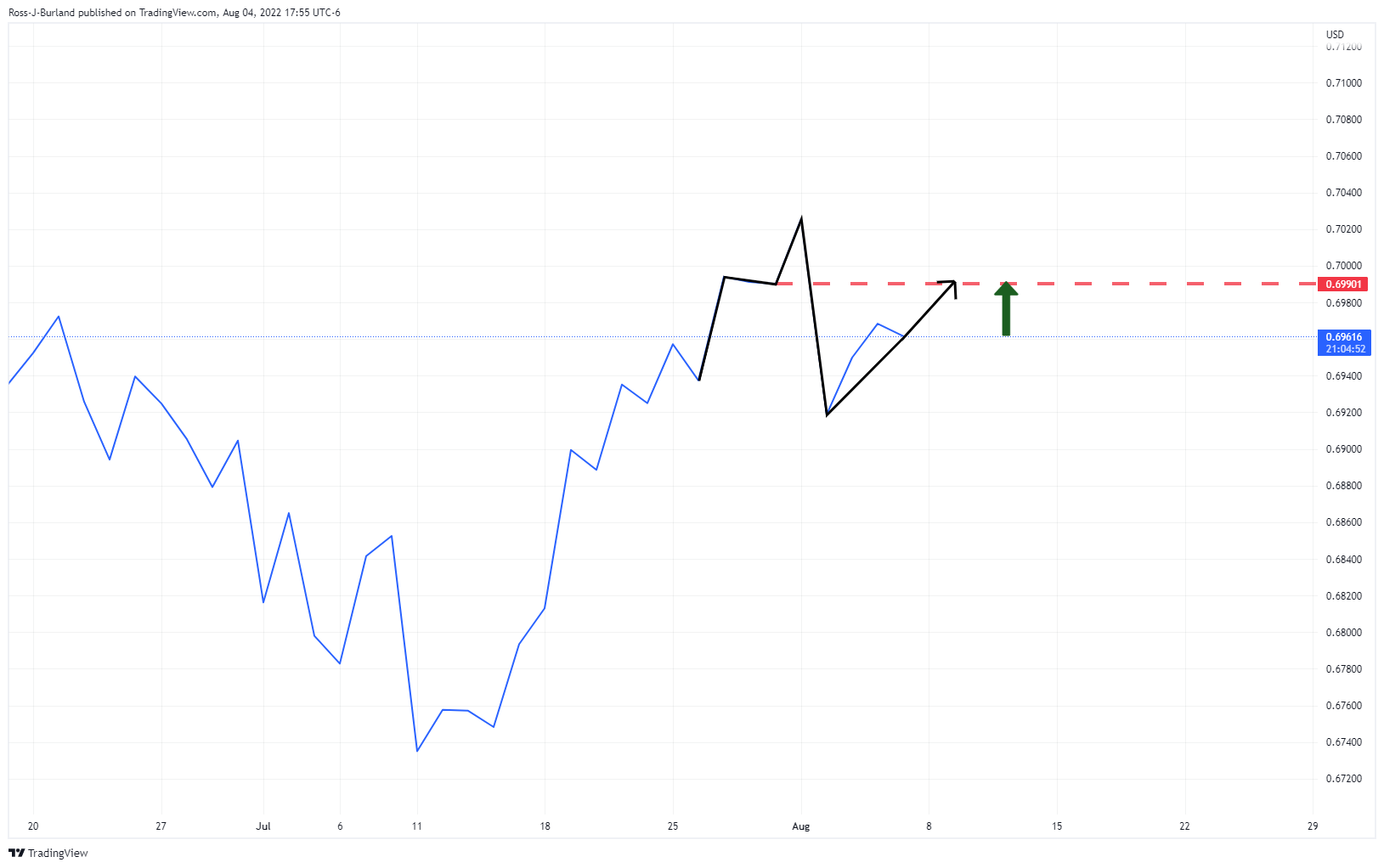- Analiza
- Novosti i instrumenti
- Vesti sa tržišta
Forex-novosti i prognoze od 05-08-2022
- AUD/USD is about to finish the week with losses of 1.10%.
- A bearish-engulfing candle pattern and the RSI’s crossing below 50 are two reasons that could tumble the AUD/USD.
- AUD/USD sellers eye a break below 0.6900, on its way towards 0.6800.
The AUD/USD drops substantially, courtesy of upbeat US economic data, which sent the major plunging from daily highs around 0.6974 towards the day’s lows at 0.6869, though as Wall Street closed, the Aussie trimmed some of those losses. At the time of writing, the AUD/USD is trading at 0.6910, down 0.82%.
AUD/USD Price Analysis: Technical outlook
The AUD/USD daily chart portrays the pair below the confluence of the August 4 low and the 50-day EMA around 0.6952. It’s worth noting that earlier, the major dived below the intersection of a five-month-old downslope trendline and the 20-day EMA, around 0.6892, but it was short-lived and bounced toward current exchange rates.
Still, the AUD/USD is downward biased for some reasons: first, the Relative Strength Index (RSI) just crossed below the 50-midline, indicating sellers are gathering momentum. And the second reason would be that the last two-daily candles formed a bearish-engulfing candle pattern, implying that sellers outweighed buyers.
Therefore, the AUD/USD path of least resistance is downwards, and the pair’s first support would be the 0.6900 figure. Once cleared, the next stop will be the 20-day EMA at 0.6892, followed by the 0.6800 mark.

AUD/USD Key Technical Levels
- The EUR/USD snaps two straight weeks of gains, drops 0.42%.
- The common currency is trendless, within the boundaries of 1.0096-1.0278.
- From a daily chart perspective, the EUR/USD might probe the 1.0096 low before a re-test of YTD lows below the parity.
The EUR/USD slumps late as Wall Street close looms, down by 0.62%, battered by an upbeat US employment report that bolstered the greenback while increasing the odds of another “jumbo” rate hike by the Fed in the September meeting. Meanwhile, the EUR/USD Is trading at 1.0180 at the time of writing.
EUR/USD Price Analysis: Technical outlook
The shared currency daily chart illustrates the pair consolidating within the 1.0096-1.0278 area. Although the US Nonfarm payrolls report underpinned the greenback, the EUR/USD stood tall and bounced off the daily low of 1.0141, reclaiming the 20-day EMA. Still, the major is subject to selling pressure, as the RSI shifted gears, aiming downwards, and crossed below its 7-day SMA, opening the door for further downside.
Hence, the EUR/USD first support would be the 20-day EMA at 1.0158. Break below will expose the bottom of the abovementioned trading range at 1.0096, which, once cleared, opens the way to refresh YTD lows below parity.
On the flip side, the EUR/USD first resistance is the 1.0200 figure. A breach of the latter will send the euro towards August’s 2 daily high at 1.0293 before probing the 1.0300 figure.

EUR/USD Daily chart
EUR/USD Key Technical Levels
- Gold price extends its gains to three straight weeks, up 0.54%.
- Stellar US jobs data exerts further pressure on the Fed, as next week CPI is eyed.
- US-China tussles add further uncertainty to the global economic outlook.
Gold price remained on the defensive late during the New York session after an early US employment report showed that the Federal Reserve is “right” about pushing back on recession chatter. However, next week’s data, led by the Consumer Price Index (CPI), might signal that probably, Fed tightening is working. Meanwhile, XAUUSD is trading at $1773.33, down by almost 1%.
Before Wall Street opened, the US Bureau of Labor Statistics revealed that the July Nonfarm Payrolls report added 528,000 people to the labor market, crushing estimates of 250,000. Even June’s data was upward revised, from 325,000 to 398,000, while the Unemployment rate continued its downward path from 3.6% to 3.5%.
Regarding wages, namely Average Hourly Earnings, an essential component of the employment report and closely watched by the Fed, rose 0.5% MoM, topping 5.1% annually.
The financial market’s reaction saw the greenback jumping, as the US Dollar Index reached a daily high of around 106.930, while the US 10-year bond yield peaked at 2.869%. Additionally, money market futures expect a 75 bps rate hike for the September meeting, while the yellow metal slashed $35, hitting a daily low at $1764 a troy ounce.
Further, Fed officials crossed wires on Thursday. Loretta Mester, Cleveland’s Fed President, said a 75 bps rate hike for September is “not unreasonable.” Earlier in the week, the St. Louis Fed President James Bullard said he favors front-loading rate hikes, further cementing the case for the FOMC September meeting.
Elsewhere, tensions between the US and China, courtesy of US House Speaker Pelosi’s trip to Taiwan, weighed on the market’s mood. Once Pelosi’s visit finished, China conducted aggressive military drills around Taiwan and announced sanctions against Nancy Pelosi and her family on Friday.
Additionally, China announced it would halt cooperation with the US in some areas, including climate change and defense while sending warships across the Taiwan Strait’s median line.
Therefore, the yellow metal price would likely remain pressured. Unless gold buyers decisively lift the price above $1800, the non-yielding metal would be vulnerable to further selling pressure.
What to watch
Next week, the US economic calendar will feature the Inflation data, namely consumer and producer indices, Initial Jobless Claims, and the University of Michigan’s Consumer Sentiment for August.
Gold (XAUUSD) Key Technical Levels
At its latest meeting, the Reserve Bank of Australia (RBA) raised the key interest rate by 50 basis points to 1.85%. According to analysts at Wells Fargo, the RBA will likely raise again in September but with a 25 bps rate hike. They see the rate peak at 3.10% by early next year.
Key Quotes:
“The August announcement dropped previous references to "withdrawal of extraordinary monetary support". Instead, this phrase was replaced with more standard language that "the increase in interest rates is a further step in the normalization of monetary conditions in Australia." This new language hints that the RBA believes it is now a bit further along the monetary tightening path, and perhaps does not need to move at an accelerated 50 bps pace anymore—also a mildly dovish tilt.”
“In its Statement on Monetary Policy, the RBA indicated it is seeking to bring inflation down in a way that keeps the economy on an "even keel". We believe this language is also consistent with a more measured pace of rate hikes. Against this backdrop, we now expect the RBA to revert to a steady pace of consecutive 25 bps rate hikes at its next several meetings in September, October, November, December and February, which would bring the Cash Rate to 3.10% by early 2023.”
Analysts at Rabobank see risks that the GBP/USD pair may trade as low as 1.14 on a 1 to 3 month perspective. They warn that the scenario assumes another break below parity for EUR/USD.
Key Quotes:
“The Bank of England’s forecast of recession underpins the vulnerability of the pound going forward. The warnings on growth over-rode any support for the currency that may otherwise have been derived from the Bank’s 50 bps rate hike, the largest incremental move in 27 years. The UK is facing months of astoundingly high inflation levels faced by a period of disinflation during potentially 5 quarters of negative GDP growth. In politics, Liz Truss, the favourite to win the Tory party leadership race, continues her charm offensive aimed at Tory party members who will choose the next UK PM in September. Her policies, however, are not necessarily in line with investors’ needs. We see risk that cable could print as low at 1.14 on a 1 to 3 month view. This assumes a continued period of broad-based USD strength.”
“We recently reined back our 3 mth forecast for EUR/GBP to 0.84 from 0.86. That said, on the assumption that EUR/USD faces another break below parity on a 1 to 3 month view, we see scope for cable to head to 1.14.”
- The USD/JPY is soaring during the week by almost 1.50%.
- A bullish-engulfing candle pattern in the daily chart opens the door for further gains.
- In the near term, a pullback towards 134.00 is on the cards.
The USD/JPY rises for the third time during the week, reaching a fresh weekly high at 135.50, spurred by positive US jobs data released on Friday, which caused a knee-jerk reaction of almost 200 pips, from around 133.07 to its aforementioned weekly high. At 135.06, the USD/JPY gains 1.66%.
USD/JPY Price Analysis: Technical outlook
USD/JPY’s Friday price action shows that the major formed a huge bullish-engulfing candle pattern, meaning buying pressure is stepping in. At the same time, the exchange rate sits above the 50-day EMA at 134.84, which, decisively broken, could pave the way towards the 20-day EMA at 136.04. Worth noting that buyers are gathering momentum, as shown by the Relative Strength Index (RSI), about to cross the 50-central line, another reason for sellers to get out of the way once buyers have regained control.
Therefore, the USD/JPY’s first resistance would be the 135.00 figure, followed by the 20-day EMA at 136.04, and then the June 22 daily high at 136.71.
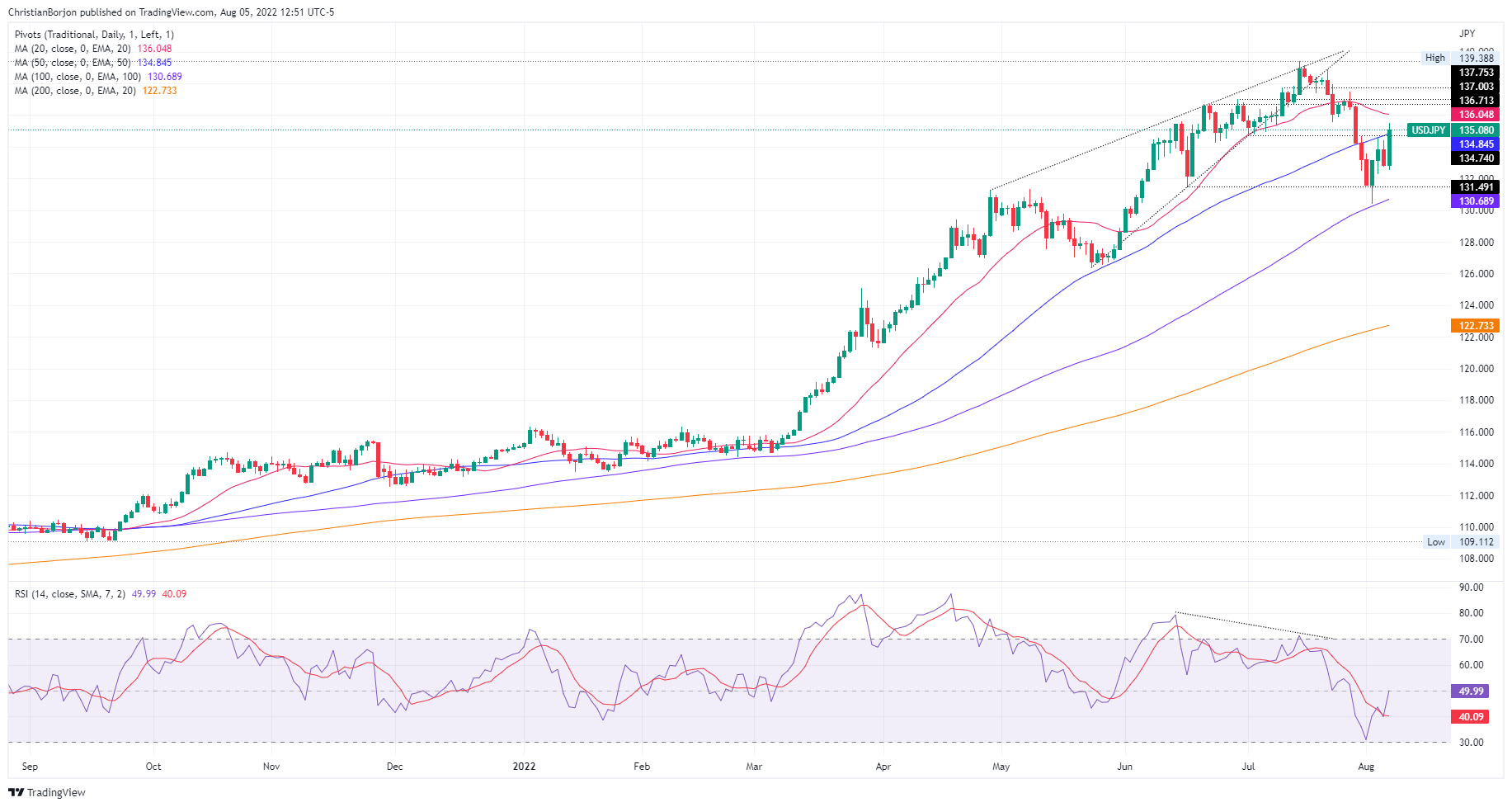
USD/JPY Daily Chart
Meanwhile, the USD/JPY hourly chart illustrates the major faced resistance near the R3 pivot at 135.60, dipping towards the R2 daily pivot point at 135.00, where bids keep the pair above the 135.00 figure. Nevertheless, the uptrend appears to be losing steam, as the Relative Strength Index reached overbought territory, meaning that buying pressure is easing, so a pullback towards the R1 daily pivot around 133.94 is on the cards.
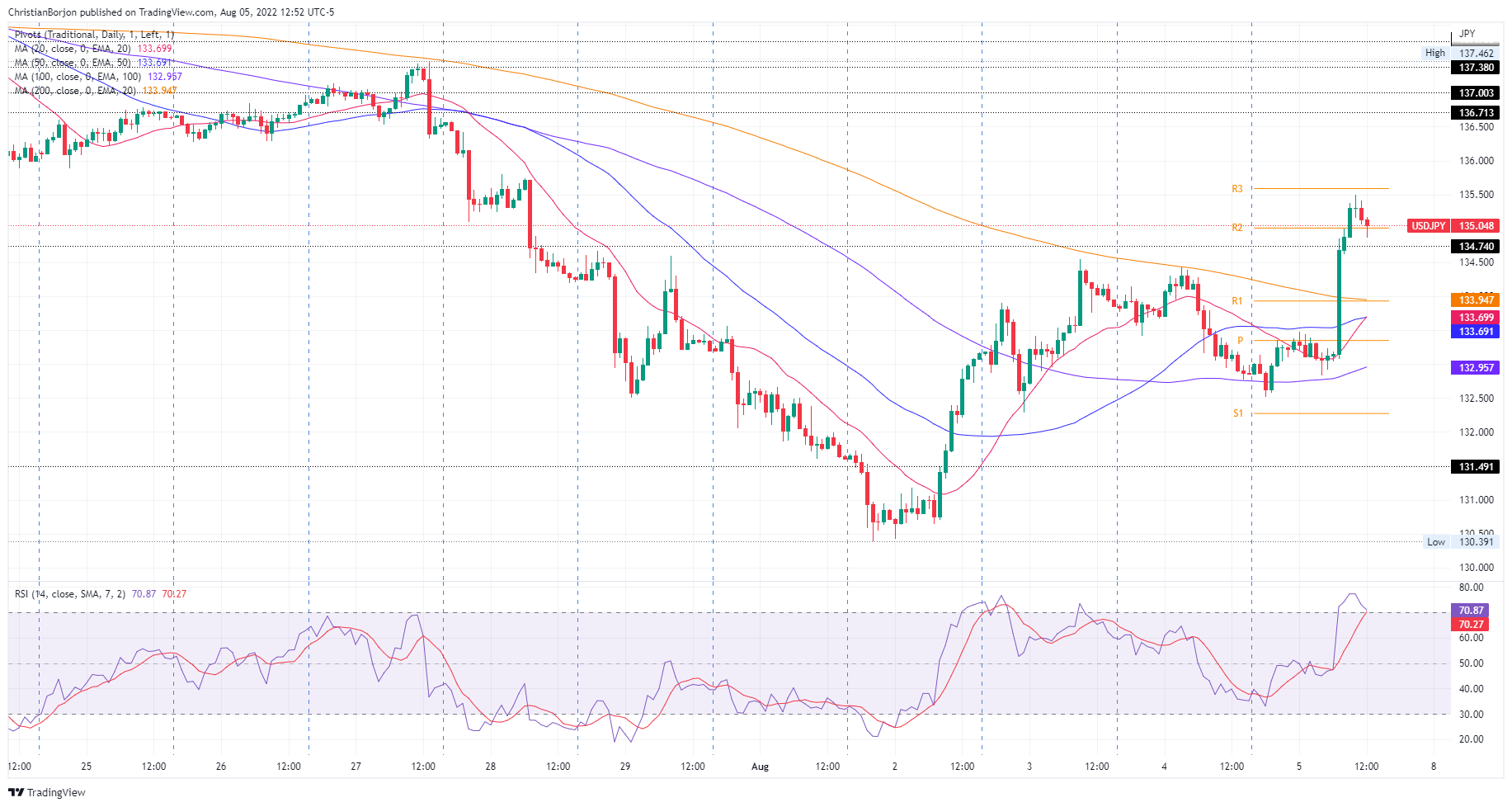
USD/JPY Hourly chart
USD/JPY Key Technical Levels
- The GBP/USD prepares to finish the week with hefty losses of 0.78%.
- US labor data poured cold water on recession fears ahead of next week’s CPI.
- BoE’s Pill: The bank will reach its inflation target, but it “will take some time.”
The GBP/USD tanks reached a fresh weekly low at 1.2002 as a reaction to a stellar US employment report which eases US recession fears while increasing the odds for further Federal Reserve aggressive tightening amidst a 9% inflation in the country.
During the day, the GBP/USD peaked at around 1.2169, but as abovementioned, it tumbled. Still, the GBP/USD is trading at 1.2078, down 0.67%, though some 70 pips above the day’s low.
GBP/USD plunged on US data
Sentiment remains mixed, with most EU stocks closing with losses while US equities wobble. On Friday, the Department of Labor revealed that July Nonfarm Payrolls added 528K jobs to the US economy, smashing estimations of 250K. Additional data from the US jobs report illustrates that the labor market remains tight, with the Unemployment rate falling to 3.5% and Average Hourly Earnings increasing 0.5% MoM while, on an annual basis, rose by 5.2%
On Thursday, Cleveland’s Fed President Loretta Mester kept her hawkish stance. She said the rate path outlined by June dot plots is “about right,” while adding that a 75 bps for September is “not unreasonable.”
Elsewhere, the Bank of England Chief Economist Huw Pill crossed wires via Bloomberg. He said that the BoE would return to its 2% inflation target but added that “it’s going to be a process, which is going to take time reflecting the magnitude of shocks we’ve seen,” on Friday. Those remarks came one day after the “old lady” raised rates by 50 bps, the most in 27 years, lifting the Bank’s Rate to 1.75%, and warned that the UK might tap into a recession by the year’s end.
All that said, the GBP/USD prepares to finish the week with losses. The resilience shown by the US economy so far, with ISM PMIs holding the fort in expansionary territory and a solid labor market, paints a positive picture for the greenback. Contrarily, the stagflationary scenario looming in the UK, we can conclude that the Sterling’s weakness could remain towards the next week.
What to watch
Next week, the UK economic docket will feature RICS House Price Balance as the only market mover data. The US docket will feature the Inflation data, namely consumer and producer indices, Initial Jobless Claims, and the University of Michigan’s Consumer Sentiment for August.
GBP/USD Key Technical Levels
- US Dollar holds onto important daily gains after NFP.
- Employment reports boost US dollar and yields.
- EUR/USD heads for a modest weekly loss.
The EUR/USD bottomed on Friday at 1.0140 and then rebounded. The recovery of the euro was not strong enough to regain 1.0200. Near the end of the week, the pair looks vulnerable, on the back of a stronger US dollar.
The July employment report showed the US economy added 528K jobs, much more than expected. US yields jumped after the report boosting the greenback across the board.
After NFP, the key report next week will be US inflation numbers. The July CPI is due on Wednesday and a monthly 0.2% increase is expected. On Thursday the PPI will be released. The numbers will be critical for Fed rate expectations. The employment report left the doors open to aggressive tightening.
Another week in the range
Despite the FOMC and the NFP, the EUR/USD continues to move sideways, as has been the case since mid-July. The euro continues to be rejected from near the 1.0280 zone while at the same time is keeps finding support around 1.0100.
“The weekly chart shows that the long-term bearish stance remains intact. Technical indicators hold within negative levels, the Momentum advancing but the RSI extending its consolidation at around 31. At the same time, the 20 SMA heads south almost vertically, roughly 350 pips above the current level but over 800 pips below the longer ones, a sign of bears’ dominance”, explains Valeria Bednarik, Chief Analysts at FXStreet.
According to Bednarik, a break below 1.0105 will open the door for a retest of parity. On the upside, she argues “EUR/USD would need to accelerate through 1.0280 to shrug off the negative stance and extend its recovery towards 1.0360 first and en route to 1.0440 then.”
Technical levels
- The USD/CHF is snapping two consecutive weeks of losses, gaining 1.37%.
- From the daily chart perspective, the major is headed upwards and will test resistance around 0.9669-75.
- If USD/CHF buyers conquer 0.9642-50, a move towards 0.9703 is on the cards.
The USD/CHF is surging during the North American session after hitting a daily low early in the Asian session at 0.9538. Still, positive US economic data spurred a jump towards the daily high at 0.9644, shy of the weekly high at 0.9651. At the time of writing, the USD/CHF is trading at 0.9638.
USDCHF Price Analysis: Technical outlook
The USD/CHF daily chart illustrates the pair as upward biased, further reinforced by the Relative Strength Index, crossing above the 50-midline, displaying that buyers are gathering momentum as the exchange rate approaches a substantial resistance area at the confluence of the 20 and 50-day EMAs, in the 0.9660-75. A decisive break would clear the way towards the July 14 daily high at 0.9886.
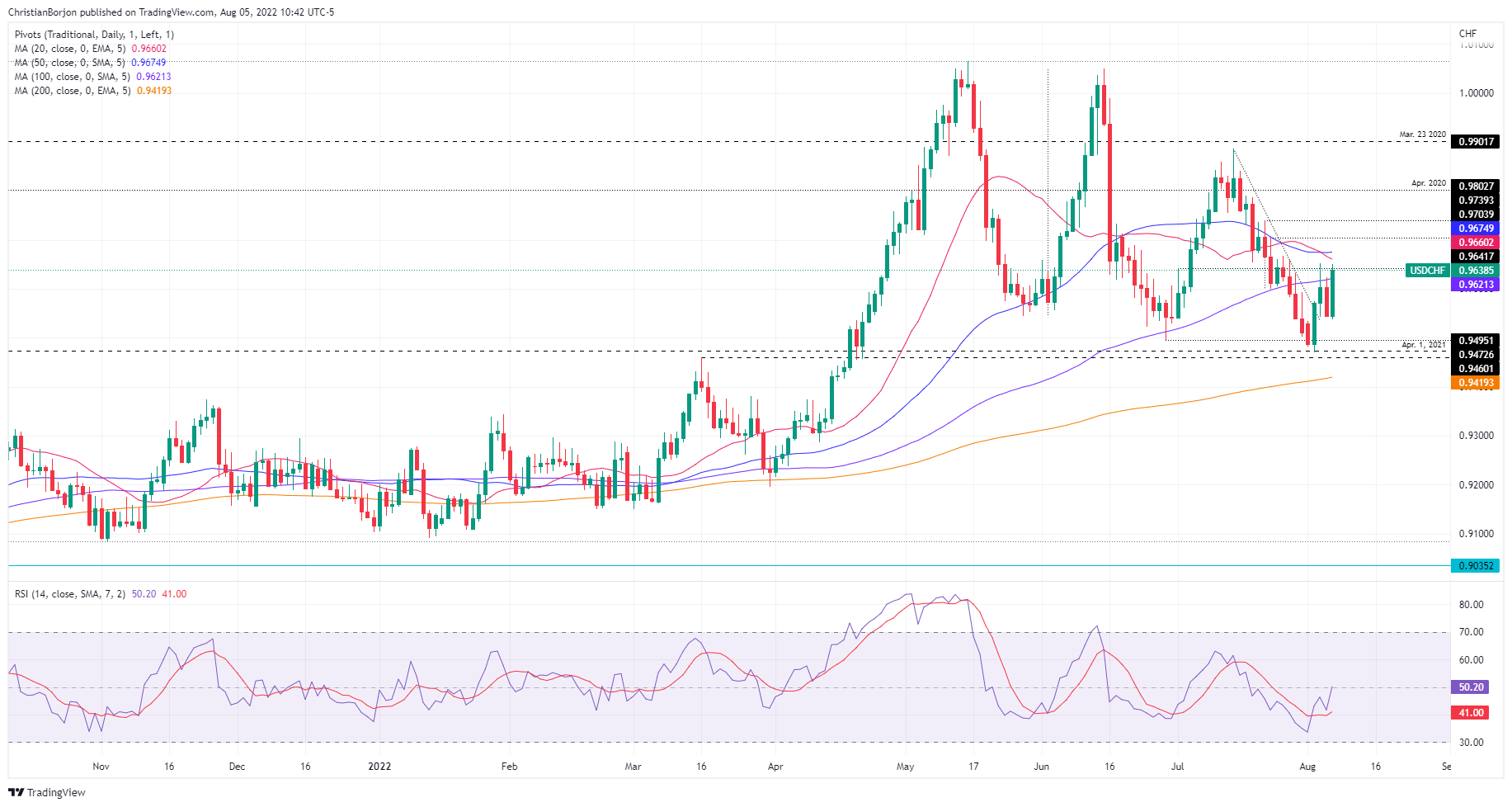
In the 4-hour scale, the USD/CHF tests the confluence of the 100, 200-EMAs and the R2 daily pivot point, in the 0.9642-52 area, which ounce cleared, could pave the way for the USD/CHF towards the July 22 high at 0.9703. Even though it’s a clouded area, the Relative Strength Index reading at 64 still has some room to spare if buyers step in to push prices higher.
On the other hand, if USD/CHF resistance holds, the major could dip towards the R1 pivot point at 0.9600.
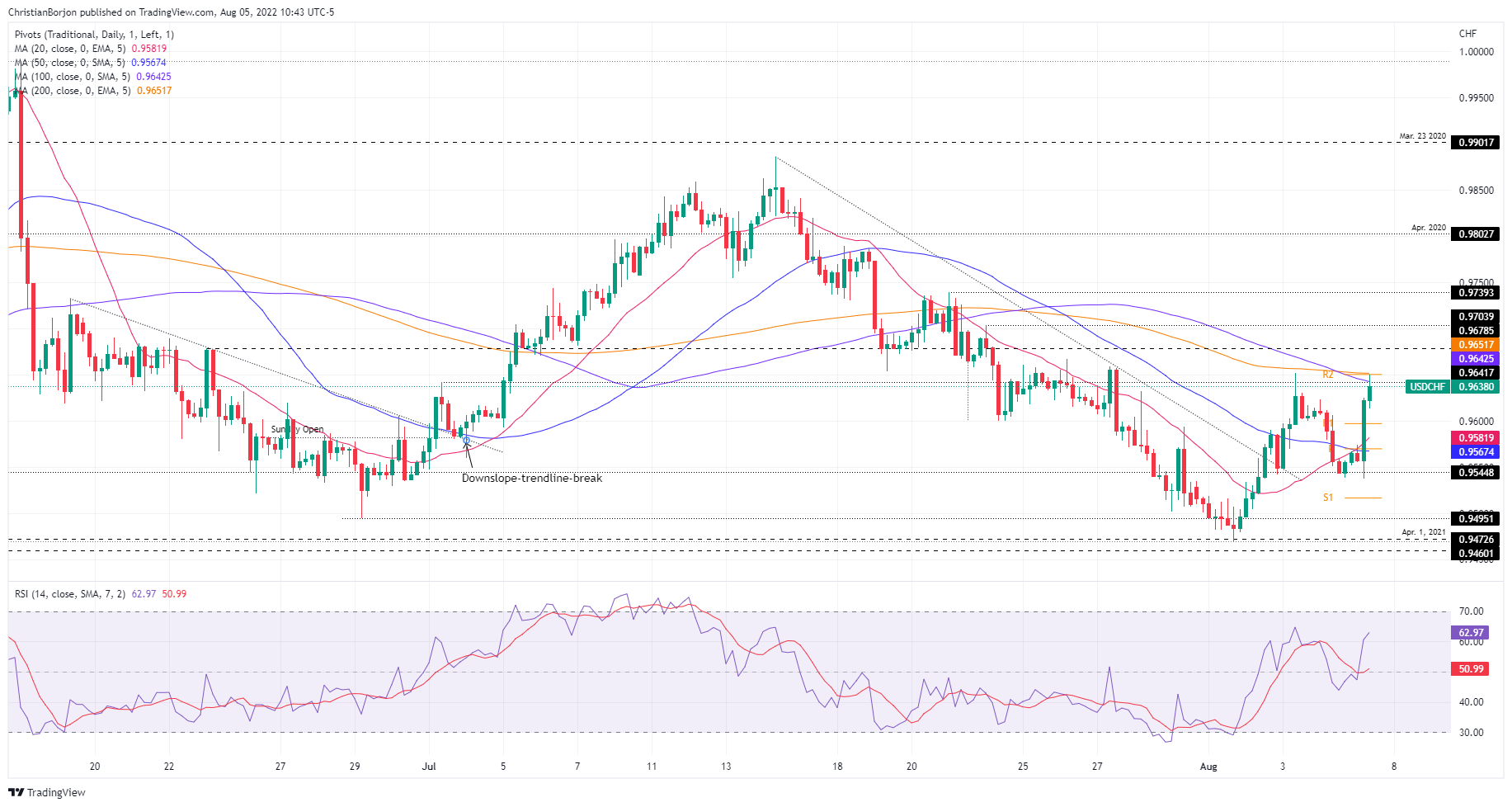
USDCHF Key Technical Level
The Canadian employment reports showed an unexpected negative change in July. Analysts at CIBC point out that while the figures muddied the waters further for policymakers, the Bank of Canada will likely focus on the historic low unemployment rate and still strong wage growth to justify another non-standard rate hike at its next meeting.
Key Quotes:
“The jobs tally fell (-31K) for a second consecutive month in July, although with labour force participation also declining the jobless rate held steady at a historic low of 4.9%. The drop in employment was roughly evenly distributed between part-time and full-time, and was driven in large part by a decline in public sector paid employment. Self-employment rose on the month, although not by enough to offset the big decline seen in June.”
“Employment fell for the second successive month in July, in what would typically be a sign of a slowing economy and potential easing of future inflationary pressure. However, at the same time labour market participation has fallen, the unemployment rate remains at a historic low and wage growth is still well above its pre-pandemic norms. Those trends would add to inflationary concerns. We suspect that for now the Bank of Canada will focus mainly on the record low unemployment rate, and deliver a further non-standard interest rate hike at its next meeting.”
The July US official employment report showed better-than-expected numbers and triggered a rally of the US dollar on Friday. According to analysts at Wells Fargo, at least a 50 bps rate hike at the September 20-21 FOMC meeting seems likely at this point in time, and yet another 75 bps hike could be in store if inflation over the next two inflation reports shows no signs of trending lower.
Key Quotes:
“If the U.S. economy is in a recession, no one seems to have told employers. Nonfarm payroll growth in July was more than double the Bloomberg consensus, registering a 528K monthly gain. This marked the second fastest pace of job growth in 2022. Employment growth was broad-based with nearly all major sectors adding jobs in the month. Average hourly earnings data added further fuel to the fire, increasing 0.5% in the month and 5.2% over the past year. The unemployment rate fell a tenth of a percentage point to 3.5%, which matches the 50-year low reached in 2019.”
“The economic data are sending mixed messages at present, and the white-hot payroll numbers look increasingly out-of-line with other data points. That said, employment growth of more than half a million jobs per month and a falling unemployment rate are hard to ignore, and we suspect this data will give the FOMC the confidence it needs to push ahead aggressively with its fight against inflation. At least a 50 bps rate hike at the September 20-21 FOMC meeting seems likely at this point in time, and yet another 75 bps hike could be in store if inflation over the next two CPI reports shows no signs of trending lower.
- US Payrolls rise above expectations in July.
- Japanese yen drops sharply as US yields soar.
- EUR/JPY rebound more than 400 pips from the weekly lows.
The EUR/JPY jumped following the release of a better-than-expected US employment report. The cross rose to 137.75, reaching the highest level in a week. It is hovering around 137.50, holding onto strong daily gains.
From the weekly low EUR/JPY has gained more than 400 pips. The sharp rebound weakened the negative outlook for the pair. On the upside, the next key resistance is at 137.90, the 20-week Simple Moving Average. A weekly close above that level should open the doors to more gains.
On Friday, EUR/JPY is rising for the fourth consecutive day boosted after the release of US employment data. Non-farm payrolls rose by 528K above the 250K expected. The numbers triggered a decline in Treasuries that weighed on the yen.
The Japanese currency tumbled across the board even as equity prices in Wall Street declined hit by higher US yields. The US 10-year yield rose from 2.70% to 2.84%.
EUR/JPY’s rally on Friday is being driven by a weaker yen. EUR/USD tumbled following NFP, falling from 1.0220 to levels under 1.0150. At the same time, USD/JPY jumped from 133.20 to 135.35.
Technical levels
- Silver price hits a daily low of $19.55 in a knee-jerk reaction to the US employment report.
- The US economy added 528K new jobs, so US bond yield surged, a headwind for precious metals.
- Silver Price Forecast (XAGUSD): Failure to break above $20.40 will keep silver exposed to sellers.
Silver price dives after US labor data crushed expectations, as traders scaled back their bets that a Fed pivot was a done deal while pouring cold water to recession fears. The greenback is rising, with the US Dollar Index, up almost 0.80% at 106.579, while the US 10-year bond yield soars 15 bps, up at 2.834%. Consequently, XAGUSD is trading at $19.91, losing 1.19%.
US and European equities shifted gears, recording losses following the US employment report. US Nonfarm Payrolls for July increased by 528K, topping expectations of just 250K. Furthermore, the prior month’s data was revised upwards to 398K, while the Unemployment Rate tick lower to 3.5%. Financial analysts chatter, put a Fed’s 75 bps rate hike on the table for the September meeting, reinforced by Average Hourly Earnings rising 0.5% MoM while on an annual basis, rose by 5.2%.
Still, the US 2s-10s yield curve inversion is a theme around financial markets desks, further deepening to -0.370%, as the US 2-year bond rate is yielding 3.211%.
In the meantime, Cleveland’s Fed President Loretta Mester spoke on Thursday and stayed hawkish. She said the rate path outlined by June dot plots is “about right,” though it should be taken with a pinch of salt after a great jobs report. She added that a 75 bps for September is “not unreasonable.”
Elsewhere, geopolitical risks keep lingering in investors’ heads. Tensions between the US and China, courtesy of US House Speaker Pelosi’s trip to Taiwan, left some scars and consequences, with China conducting aggressive military drills around Taiwan and announcing sanctions against Nancy Pelosi and her family.
What to watch
Next week, the US economic calendar will feature the Inflation data, namely consumer and producer indices, Initial Jobless Claims, and the University of Michigan’s Consumer Sentiment for August.
Silver Price Analysis (XAGUSD): Technical outlook
The XAGUSD daily chart illustrates the pair is still facing solid resistance around the $20.00-$20.40 area, with buyers unable to crack it. Traders should note that the 50-day EMA, around $20.35, is where sellers had been leaning to, but news propelling higher US bond yields would likely keep buyers at bay. Therefore, the XAGUSD next support to test will be $19.50, followed by the 20-day EMA at $19.23.
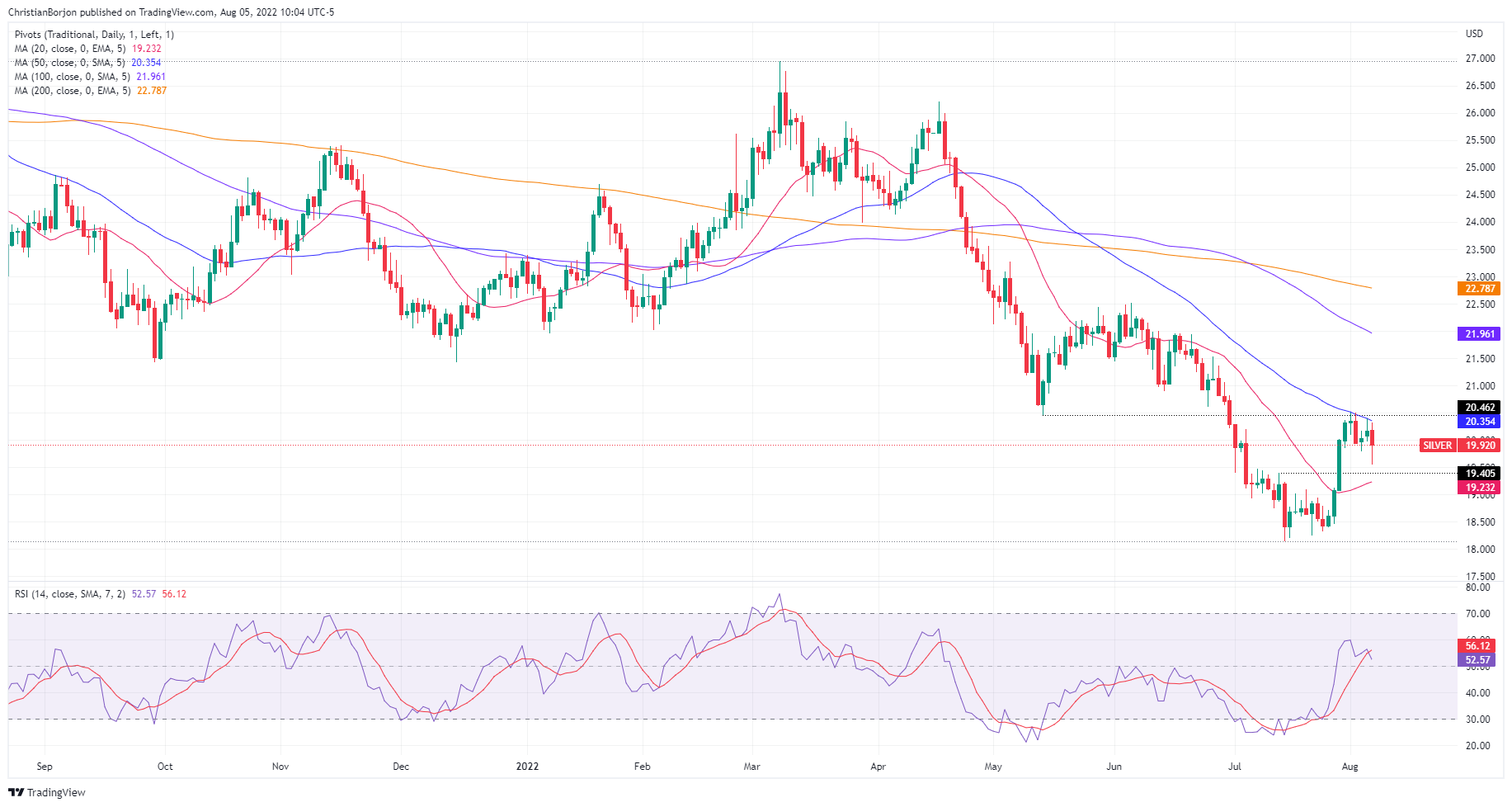
- NZD/USD drops hard following the US NFP report.
- The price is left testing a familiar cluster of daily support.
NZD/USD has dropped on the back of a rally in the US dollar on Friday due to an astonishing outcome in the US labour market data. Nonfarm Payrolls in the US rose by 528,000 in July, the data published by the US Bureau of Labor Statistics revealed on Friday. This reading followed June's increase of 398,000 (revised from 372,000) and came in better than the market expectation of 250,000. The Unemployment Rate edged lower to 3.5%.
Meanwhile, from a technical perspective, they are no clearer to the eye while the price remains bound by a cluster of daily support and resistance. The pair has been trading in a wide range since breaking out of the daily trendline resistance, failing to maintain a directional bias over the past two weeks of choppiness. The following illustrates the current structure and potential scenarios for the coming days.
NZD/USD daily chart
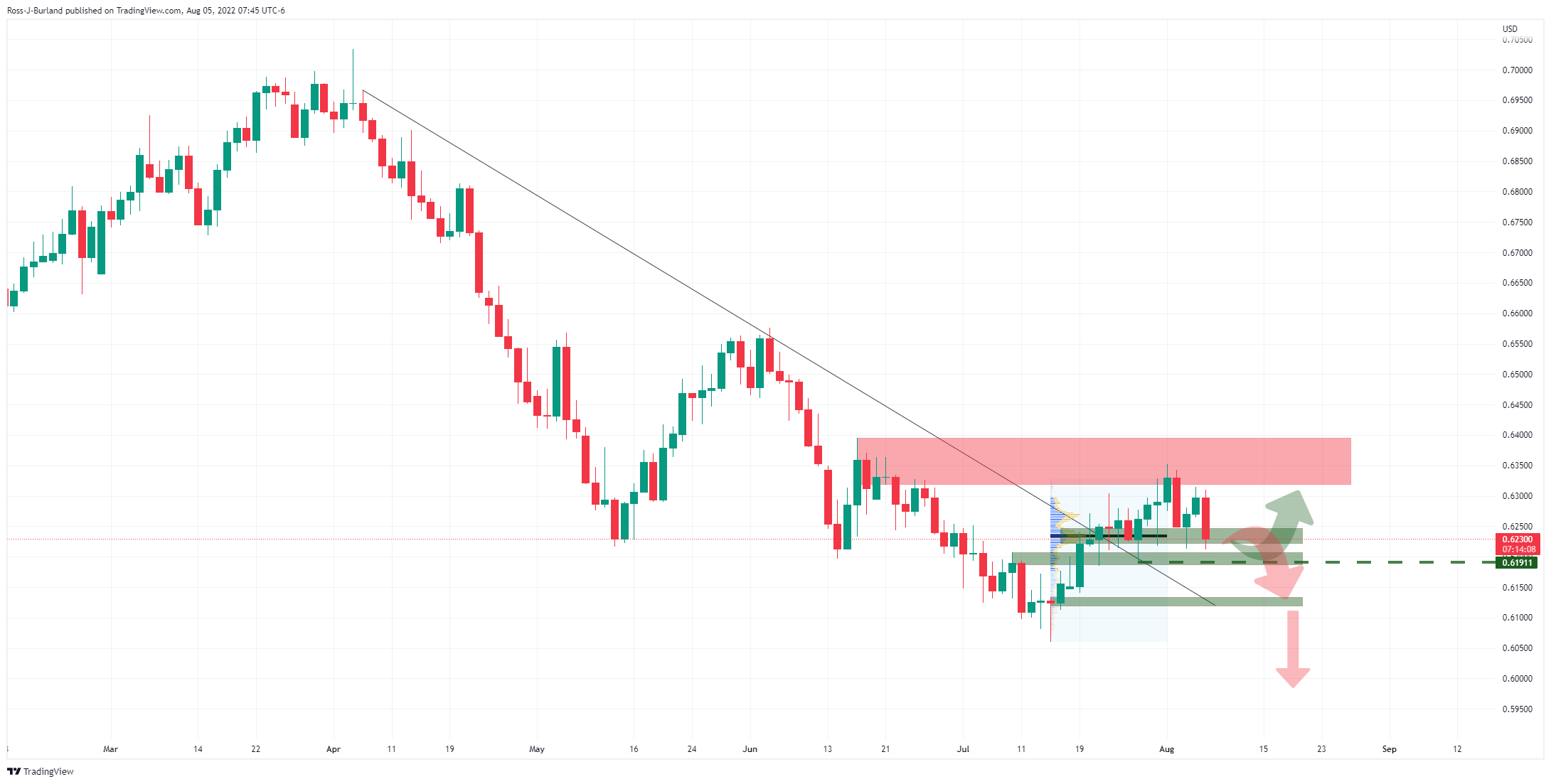
The price is testing a cluster of support on the daily chart with 0.6190 a potential key structure that if broken will open the risk of a significant sell-off towards a test of 0.61 the figure. Below there, 0.5900 will be eyed. However, should the bulls somehow manage to fend off the bears, then there will be prospects of a move into the recent highs that guard a breakout to the upside.
Economists at Commerzbank provide their afterthoughts on the stellar US monthly jobs report, which showed that the economy added a whopping 528K jobs in July and the unemployment rate fell to 3.5%. The upbeat employment details now seem to have revived hopes for a larger Fed rate hike move at the September policy meeting.
Key Quotes:
“With the U.S. economy having contracted in the first two quarters of 2022, the definition of a "technical recession" popular in financial markets is fulfilled. However, the labor market, which has been very robust so far, should in the end determine whether the economy is headed for a real recession with rising unemployment and falling consumer spending.”
“At the press conference after the July meeting, Fed Chairman Powell explicitly referred to the two employment reports due before the September meeting. These would help determine whether the Fed would have to continue to apply the brakes forcefully. The first of these two data points has now been published – and shows that the labor market continues to run hot. The cooling hoped for by the Fed to lower inflationary pressure has failed to materialize. As a result, calls for another 75 basis points rate hike are likely to grow louder in the FOMC.”
- The index gathers extra pace following July’s NFP.
- The US economy created more jobs than expected last month.
- The US jobless rate ticked lower to 3.5% in July.
The greenback, in terms of the US Dollar Index (DXY), accelerates the upside to new monthly tops around 107.00 on Friday.
US Dollar Index boosted by Payrolls figures
The index rebounds sharply and already flirt with the 107.00 zone following the solid prints from the US Nonfarm Payrolls for the month of July.
Indeed, the upside momentum in the buck picked up extra pace after the US economy added 528K jobs during last month vs. markets’ consensus for a 250K increase. In addition, the jobless rate ticked lower to 3.5% while Average Hourly Earnings also surprised to the upside rising 0.5% MoM and 5.2% over the last twelve months.
The sharp bounce in the index comes reinforced by the equally strong rebound in US yields across the curve. In fact, the short end revisits the multi-week highs past 3.25%, as speculation of a now faster normalization by the Fed has started to run high among investors.
What to look for around USD
Higher-than-expected Payrolls results for the month of July appear to have reignited the perception of a more aggressive Fed’s rate path in the next months, lending extra support to both the dollar and yields.
Also bolstering the constructive outlook for the buck emerges the Fed’s divergence vs. most of its G10 peers (especially the ECB) in combination with bouts of geopolitical effervescence and occasional re-emergence of risk aversion.
Key events in the US this week: Non-Farm Payrolls, Unemployment Rate, Consumer Credit Change (Friday).
Eminent issues on the back boiler: Hard/soft/softish? landing of the US economy. Escalating geopolitical effervescence vs. Russia and China. Fed’s more aggressive rate path this year and 2023. US-China trade conflict. Future of Biden’s Build Back Better plan.
US Dollar Index relevant levels
Now, the index is gaining 0.93% at 106.73 and a break above 107.42 (weekly high post-FOMC July 27) would expose 109.29 (2022 high July 15) and then 109.77 (monthly high September 2002). On the other hand, the next support emerges at 105.04 (monthly low August 2) seconded by 104.96 (55-day SMA) and finally 103.67 (weekly low June 27).
- Gold witnesses aggressive selling and tumbles to the daily low amid the post-NFP strong USD buying.
- The upbeat report lifts bets for a 75 bps Fed rate hike in September, which further weighs on the metal.
- The risk-off impulse could offer some support to the safe-haven XAU/USD and help limit further losses.
Gold comes under intense selling pressure during the early North American session and plummets to a fresh daily low, around the $1,765 area in the last hour.
The US dollar strengthens across the board on a stronger-than-expected employment report and turns out to be a key factor weighing heavily on the dollar-denominated gold. The headline NFP print showed that the US economy added a whopping 528K jobs in July, smashing expectations by a huge margin. Furthermore, the previous month's reading was also revised higher to 398K from the 372K, while the unemployment rate also surprisingly edged down to 3.5% from 3.6% in June.
The upbeat macro data lifts market bets for a larger Fed rate hike move at the September meeting, which further contributes to driving flows away from the non-yielding yellow metal. The odds of a 75 bps hike jump to 70% from 40% before the jobs report and trigger a sharp spike in the US Treasury bond yields. In fact, the yield on the benchmark 10-year US government bond climbs back closer to the weekly high and exerts additional downward pressure on gold.
The prospects for more aggressive policy tightening by the Fed, meanwhile, tempered investors' appetite for riskier assets. This is evident from a fresh leg down in the equity markets, which could lend some support to the safe-haven gold and help limit any deeper losses, at least for the time being. Hence, any subsequent downfall is more likely to find decent support near the weekly low, around the $1,754 area, which coincides with a strong hurdle cleared last week.
Technical levels to watch
- AUD/USD is knocked for six on the strong NFP headline.
- The price is taking on 4-hour support, a break of that opens the risk of a deeper run below the countertrend line to test 0.68 the figure.
AUD, sensitive to risk tones in financial markets, has been battered by a doubling of market expectations in the Nonfarm Payrolls outcome. AUD/USD has fallen to 0.6882, dropping three pips below the August 2 lows. This move could be carving out a technical bearish breakout towards 0.6900 as illustrated below.
NFP doubles market expectations
- Breaking: US Nonfarm Payrolls rise by 528,000 in July vs. 250,000 expected
Nonfarm Payrolls in the US rose by 528,000 in July, the data published by the US Bureau of Labor Statistics revealed on Friday. This reading followed June's increase of 398,000 (revised from 372,000) and came in better than the market expectation of 250,000. The Unemployment Rate edged lower to 3.5%.
Further details of the publication revealed that the annual wage inflation, as measured by the Average Hourly Earnings, remained unchanged at 5.2%, compared to analysts' estimate of 4.9%. Finally, the Labor Force Participation Rate declined to 62.1% from 62.%.
Investors had been in anticipation of the report for further hints of how the US economy is faring considering a data-dependent Federal Reserve. The data now raises the prospects of a 75 bp hike from the Federal Reserve which is not going to be favourable for risk sentiment or the Aussie that tends to track the performance of global stock markets. The odds of a 75 bps hike have leapt to 61% from 40% on the release.
US dollar tears higher on NFP
Meanwhile, ahead of the jobs data, the US dollar edged higher on Friday in a correction of some of the sharpest daily drop in more than two weeks, sliding 0.68% on Thursday, the largest fall since July 19. The US dollar index (DXY), which measures the greenback against a basket of currencies, was up 0.15% to 105.90 just ahead of the data release, a touch below the day's high of 106.00. While the data is being digested, the index is rallying to a high of 106.808 so far, up over 1% on the day so far.
AUD/USD technical analysis
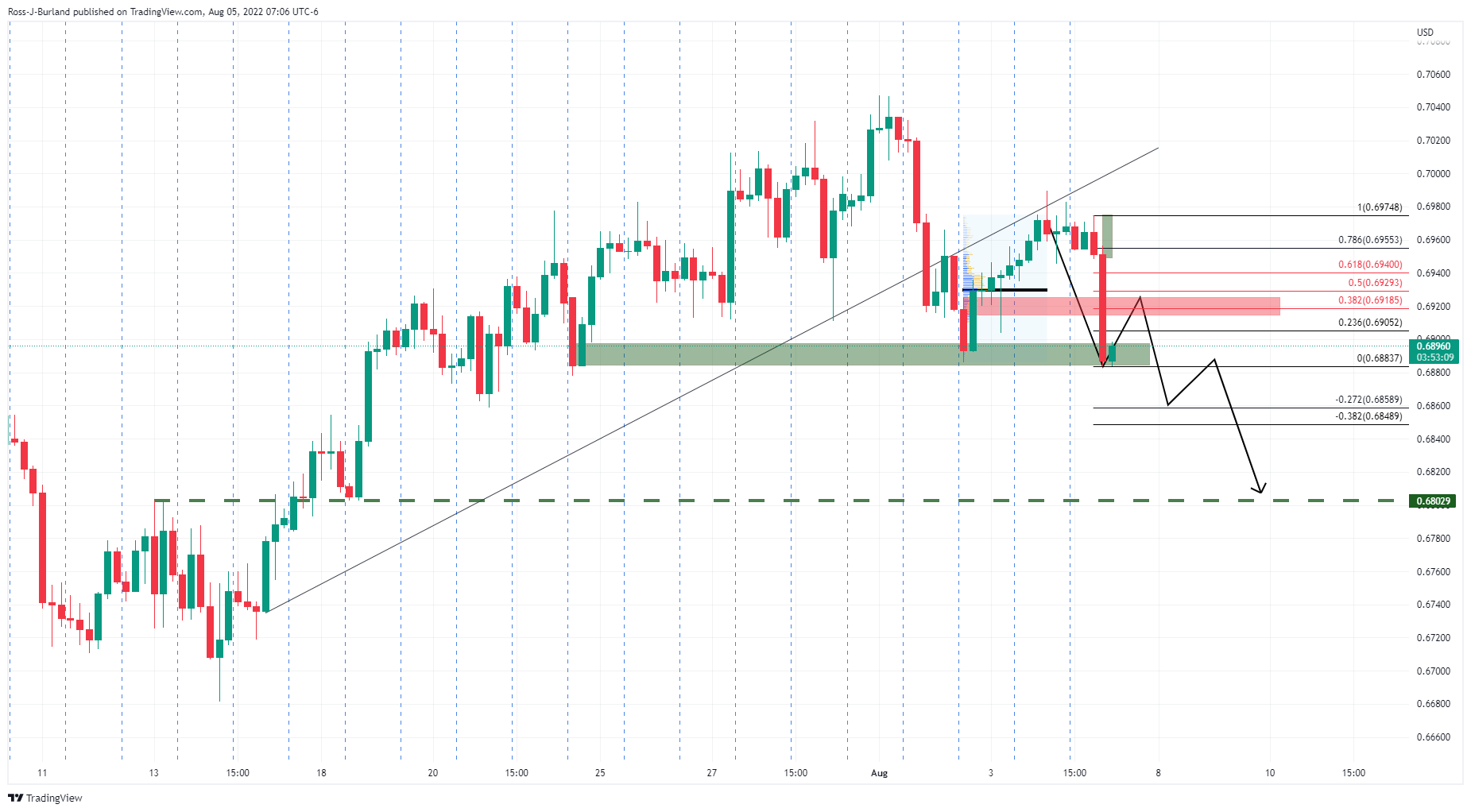
The price is taking on 4-hour support. There are prospects of a correction following this knee-jerk sell-off as the markets continue to position themselves around the data. There is scope for the price to correct to a higher area of volume to the upside near 0.6920/0.6940, but given the strength of the sentiment surrounding the Fed, a break below the lows printed today opens the risk of a deeper run below the countertrend line to test 0.68 the figure and a prior resistance structure.
- USD/JPY rallies to over a one-week high in reaction to stellar US employment details.
- The US economy added 528K jobs in July and the unemployment rate fell to 3.5%.
- The risk-off impulse fails to benefit the safe-haven JPY or hinder the strong move up.
The USD/JPY pair catches aggressive bids during the early North American session and jumps to over a one-week high, around the 134.85 region in reaction to the stellar US jobs report.
The headline NFP print smashed consensus estimates and showed that the US economy added a whopping 528K jobs in July, more than doubling the 250K anticipated. Adding to this, the previous month's reading was also revised higher from 372K to 398K. Furthermore, the unemployment rate surprisingly fell to a pre-pandemic low of 3.5% from 3.6% in June.
Against the backdrop of more hawkish comments by several Fed officials this week, the upbeat employment details revive bets for a larger interest rate hike at the September FOMC policy meeting. In fact, the odds for a 75 bps hike have jumped to 61% from the 40% ahead of the release, which triggers a sharp spike in the US Treasury bond yields.
This, in turn, results in the widening of the US-Japan rate differential, which, along with a strong pickup in the US dollar demand, provides a solid boost to the USD/JPY pair. The combination of supporting factors helps offset the risk-off impulse, which does little to benefit the safe-haven Japanese yen or cap gains for the major.
With the latest leg up, spot prices confirm a near-term breakout through the 134.50-134.55 intermediate hurdle, suggesting that any pullback could be seen as a buying opportunity. Some follow-through buying beyond the 135.00 psychological mark would reaffirm the positive outlook and pave the way for a further appreciating move for the USD/JPY pair.
Technical levels to watch
- Unemployment Rate in Canada stayed unchanged at 4.9% in July.
- USD/CAD posts strong daily gains above 1.2950 after the data.
The Unemployment Rate in Canada was virtually unchanged at 4.9% in July, Statistics Canada reported on Friday. This reading came in slightly better than the market expectation of 5%.
On a negative note, Net Change in Employment arrived at -30.6K, missing analysts' estimate for an increase of 20,000 by a wide margin.
"The average hourly wages of employees were up 5.2% (+$1.55 to $31.14) on a year-over-year basis in July, matching the pace of wage growth recorded in June," the publication further read.
Market reaction
The USD/CAD pair rose sharply in the early American session but this move seems to have been fueled by the renewed dollar strength on the upbeat US July jobs report. As of writing, the pair was up 0.75% on the day at 1.2960.
- NFP beats market expectations and sends the US dollar higher.
- GBP/USD bulls pushed back to the London open and session lows.
On the back of the US Nonfarm Payrolls that have come in at the hotter end of expectations, the US dollar has rallied, weighing heavily on its peers, including sterling.
GBP/USD has dropped to test the lows of the day on the knee-jerk. GBP/USD had been trading between a 45 pip box during the London morning between 1.2170 and 1.2125 ahead of the data, setting a meanwhile range for the day ahead, but bears are penetrating this box to the downside with a potential bearish breakout below 1.2050 now on the cards.
NFP doubles market expectations
- Breaking: US Nonfarm Payrolls rise by 528,000 in July vs. 250,000 expected
Nonfarm Payrolls in the US rose by 528,000 in July, the data published by the US Bureau of Labor Statistics revealed on Friday. This reading followed June's increase of 398,000 (revised from 372,000) and came in better than the market expectation of 250,000. The Unemployment Rate edged lower to 3.5%.
Further details of the publication revealed that the annual wage inflation, as measured by the Average Hourly Earnings, remained unchanged at 5.2%, compared to analysts' estimate of 4.9%. Finally, the Labor Force Participation Rate declined to 62.1% from 62.%.
Investors had been in anticipation of the report for further hints of how the US economy is faring. The jobs report is a relief for the greenback when taking into consideration the data on Thursday showed that the number of Americans filing new claims for unemployment benefits increased last week. However, the data now raises the prospects of a 75 bp hike from the Federal Reserve which is not going to be favourable for risk sentiment nor the pound. The odds of a 75 bps hike have leaped to 61% from 40% on the release.
The data coincides with stark warming from the Bank of England earlier this week which raised rates by the most in 27 years to fight surging inflation in a dovish 50 bp hike to 1.75%. The central bank followed up by saying that a long recession was coming, beginning in the fourth quarter of this year, highlighting the bleak outlook for the UK economy and the pound. ''
The central bank clearly believes a deep recession is not only inevitable but also necessary to bring down inflation. This will put it on a collision course with 10 Downing Street,'' analysts at Rabobank said.
US dollar rallies on NFP
Meanwhile, ahead of the jobs data, the US dollar edged higher on Friday in a correction of some of the sharpest daily drop in more than two weeks, sliding 0.68% on Thursday, the largest fall since July 19. The US dollar index (DXY), which measures the greenback against a basket of currencies, was up 0.15% to 105.90 just ahead of the data release, a touch below the day's high of 106.00. While the data is being digested, the index is rallying to a high of 106.5510 so far, now up over 0.68% on the day so far.
GBP/USD technical analysis
The price has moved out of a 4-hour rising channel with 1.2063 as a potentially key level on the downside. A break of there could open the avenue for a significant sell-off in the coming week with 1.1950 daily trendline support eyed:
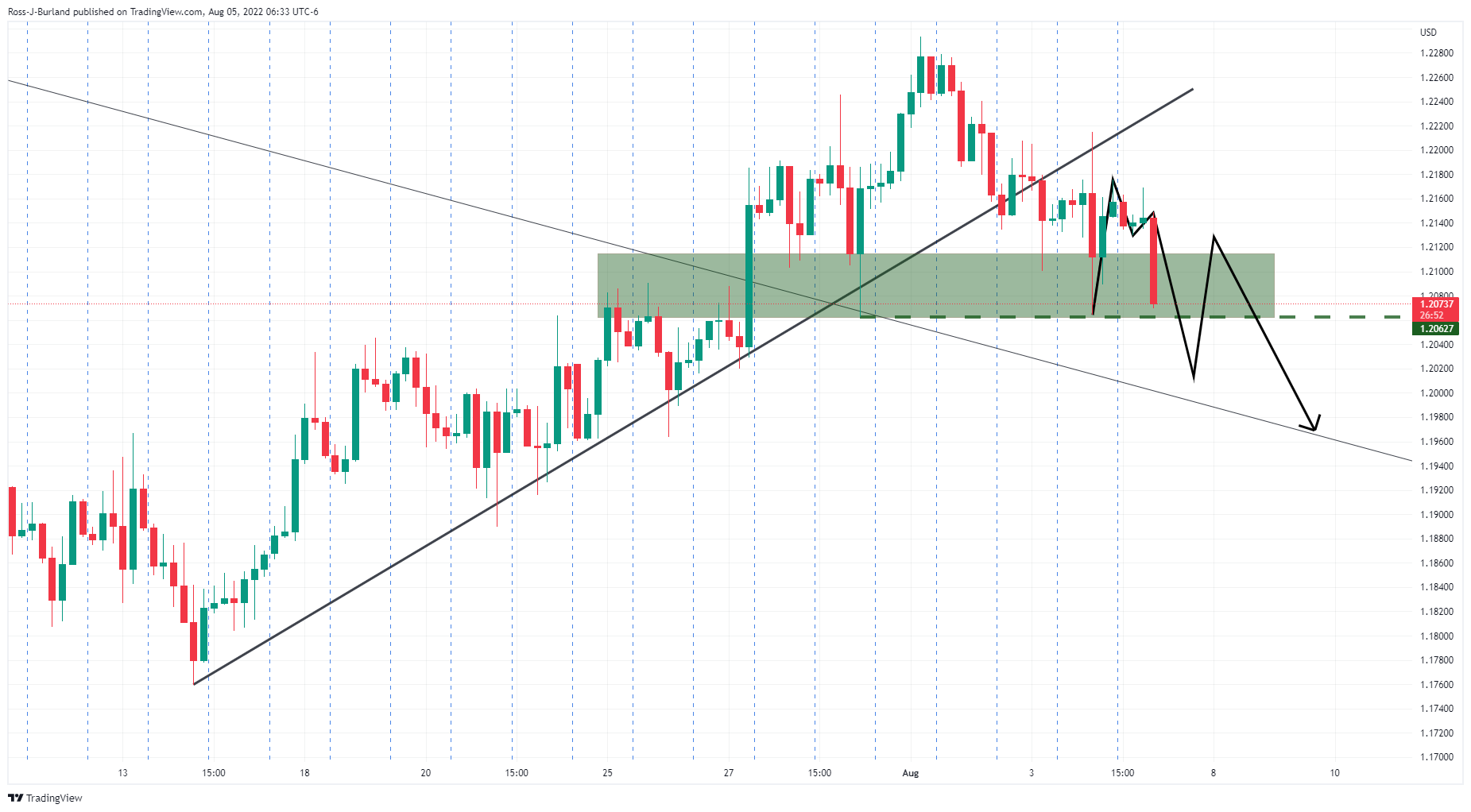
GBP/USD daily chart
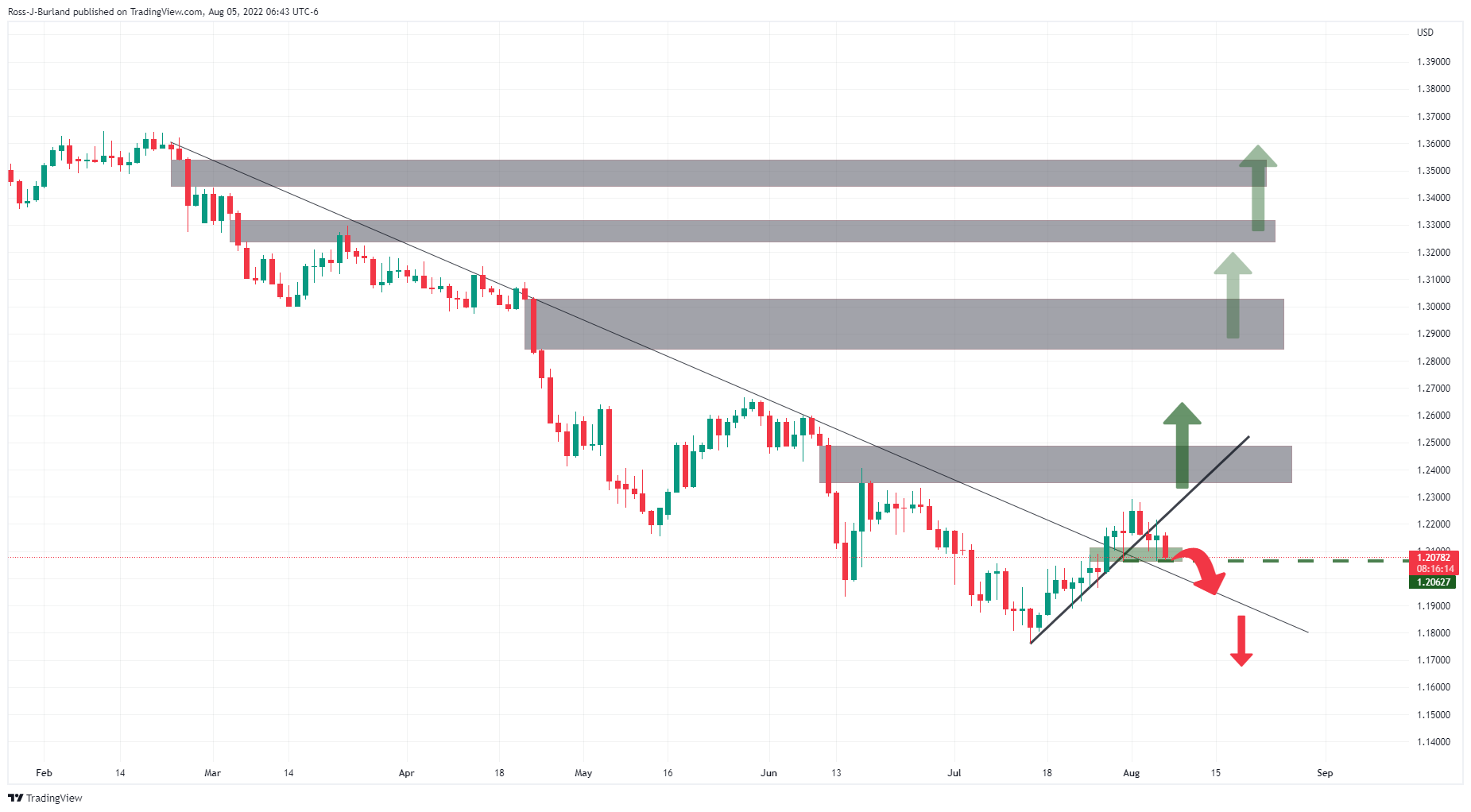
- USD/CAD catches fresh bids following the release of upbeat US monthly employment details.
- The US economy added 528K jobs in July, and the unemployment rate ticked lower to 3.5%.
- The dismal Canadian jobs report overshadows an uptick in oil prices and fails to benefit the loonie.
The USD/CAD pair builds on the overnight positive move and gains some follow-through traction for the second straight day on Friday. The intraday buying picks up pace in reaction to the upbeat US monthly jobs report and lifts spot prices to a nearly two-week high, closer to mid-1.2900s during the early North American session.
The headline NFP showed that the US economy added 528K jobs in July, surpassing the most optimistic estimates and market expectations for a rise of 250K. Furthermore, the previous month's reading was also revised higher to 398K from the 372K, while the unemployment rate also surprisingly edged down to 3.5% from 3.6% in June.
Additional details revealed that the Average Hourly Earnings rose 5.2% YoY and pointed to a further rise in inflationary pressures. The stronger data revives bets for a large Fed rate hike move at the September meeting and pushes the US Treasury bond yields higher, which, in turn, is providing a goodish boost to the US dollar.
Apart from this, weaker Canadian employment details weigh on the domestic currency and turn out to be another factor that contributes to the USD/CAD pair's sudden spike over the past hour or so. Statistics Canada reported that the number of employed people fell by 30.6K in July against estimates for an additional 20K jobs.
The combination of aforementioned factors overshadows a modest uptick in crude oil prices, which fail to lend support to the commodity-linked loonie or hinder the USD/CAD pair's positive move. This, in turn, supports prospects for a further intraday appreciating move, which should allow bulls to reclaim the 1.3000 psychological mark.
Technical levels to watch
- EUR/USD sparks a deeper correction following July’s NFP.
- US Non-farm Payrolls rose by 528K jobs in July.
- The unemployment rate ticked lower to 3.5%.
EUR/USD saw its downside accelerated to the 1.0170 region in the wake of the publication of the US jobs report for the month of July.
EUR/USD weaker on solid US jobs report
EUR/USD remains on the defensive on Friday after US Nonfarm Payrolls showed the US economy added 528K jobs during July, more than doubling the consensus for a gain of 250K jobs. The June’s reading was revised up to 398K (from 384K).
Further data saw the Unemployment Rate improve to 3.5% and the key Average Hourly Earnings – a proxy for inflation via wages – rise 0.5% MoM and 5.2% vs. the same month of 2021. Additionally, the Participation Rate, eased a tad to 62.1%.

EUR/USD levels to watch
So far, spot is retreating 0.71% at 1.0173 and faces the next contention at 1.0096 (weekly low July 26) followed by 1.0000 (psychological level) and finally 0.9952 (2022 low July 14). On the other hand, the breakout of 1.0293 (monthly high August 2) would target 1.0404 (55-day SMA) en route to 1.0615 (weekly high June 27).
Nonfarm Payrolls in the US rose by 528,000 in July, the data published by the US Bureau of Labor Statistics revealed on Friday. This reading followed June's increase of 398,000 (revised from 372,000) and came in better than the market expectation of 250,000. The Unemployment Rate edged lower to 3.5%.
Further details of the publication revealed that the annual wage inflation, as measured by the Average Hourly Earnings, remained unchanged at 5.2%, compared to analysts' estimate of 4.9%. Finally, the Labor Force Participation Rate declined to 62.1% from 62.%.
Follow our live coverage of market reaction to the US jobs report.
Market reaction
With the initial market reaction, the greenback gathered strength against its rivals and the US Dollar Index was last seen rising 0.65% on the day at 106.45.
Win Thin, Global Head of Currency Strategy at BBH, offers a brief overview of the US dollar price action on Friday and the closely-watched US monthly jobs data. The popularly known NFP report would play a key role in influencing the near-term USD price dynamics amid the recent hawkish remarks by several Fed officials.
Key Quotes:
“DXY has risen 3 of the past 4 days and is trading near 106 currently. We maintain our strong dollar call as Fed officials are making it clear that markets misread the Fed’s commitment to lowering inflation. The greenback is also getting more traction as data came in stronger than expected. Today’s jobs data will likely be key for the medium-term dollar outlook.”
“Consensus sees 250k jobs added vs. 372k in June, while the unemployment rate is expected to remain steady at 3.6% and average hourly earnings are seen falling two ticks to 4.9% y/y. Fed Chair Powell stressed labor market strength many times in his post-decision press conference, which supports our view that the Fed is not about to pivot while the economy remains at full employment. June consumer credit will be also reported and is expected at $27.0 bln vs. $22.347 bln in May.”
“WIRP suggests a 50 bp hike September 21 is fully priced in, with around 40% odds of a larger 75 bp move. The swaps market is pricing in 100 bp of tightening over the next 6 months that sees the policy rate peak near 3.5%, followed by the start of an easing cycle over the subsequent 6 months. The Fed has made it clear that this is not its expected rate path and so we look for a hawkish shift in market pricing in the coming days and weeks if the U.S. data cooperate.”
- EUR/USD gives away part of Thursday’s advance, stays around 1.0220.
- The pair needs to clear 1.0300 to allow for a more serious recovery.
EUR/USD comes under pressure after faltering once again in the 1.0250/60 region at the end of the week.
The so far August high at 1.0293 (August 2) emerges as the magnet for bulls for the time being. Above this level, spot is expected to see its uptrend reinvigorated and could challenge the temporary 55-day SMA in the near term, today at 1.0404.
In the longer run, the pair’s bearish view is expected to prevail as long as it trades below the 200-day SMA at 1.0927.
Canadian employment details overview
Statistics Canada is scheduled to publish the monthly employment details for July later this Friday at 12:30 GMT. The Canadian economy is anticipated to have added 20K jobs during the reported month, up sharply from the 43.2K decline reported in June. Meanwhile, the unemployment rate is expected to edge higher to 5.0% in July from the 4.9% previous.
Analysts at TD Securities (TDS) are more optimistic about the report and explain: “We look for job growth of 38k in July, driven by a partial rebound for trade services and natural resources after their sharp decline in June. Full-time hiring should lead the increase, while stronger labour force participation should keep unemployment stable at 4.9%. We also expect to see wage growth firm to 6.0% y/y in July, although AHE (Average Hourly Earnings) should slow on a m/m basis.”
How could the data affect USD/CAD?
The data is likely to be overshadowed by the simultaneous release of the closely-watched US jobs report - popularly known as NFP. That said, a significant divergence from the expected readings should influence the Canadian dollar and provide some meaningful impetus to the USD/CAD pair.
Heading into the key data risks, spot prices climbed back closer to the weekly high amid a goodish pickup in the USD demand. That said, a goodish recovery in crude oil prices could underpin the commodity-linked loonie and cap the upside for the USD/CAD pair.
Any disappointment from the Canadian data would be enough to assist the USD/CAD pair to confirm a near-term bullish breakout through the 1.2900 mark. The subsequent strength would set the stage for a more towards mid-1.2900s en route to the 1.3000 psychological mark and the next relevant hurdle near the 1.3055-1.3060 region.
Conversely, stronger domestic data should lend additional support to the Canadian dollar and prompt fresh selling around the USD/CAD pair. That said, any further decline below the 1.2835-1.2830 region is more likely to find decent support near the 1.2800-1.2790 zone. A convincing break below the latter would be seen as a fresh trigger for bearish traders. Spot prices could then accelerate the fall towards the 1.2700 mark before eventually dropping to the 1.2655-1.2650 region.
Key Notes
• USD/CAD Forecast: Bulls await move beyond 1.2900, US/Canadian jobs report in focus
• USD/CAD buyers approach 1.2900 ahead of US/Canada employment data
• CAD/USD about to move towards the 0.7877 level
About the Employment Change
The employment Change released by Statistics Canada is a measure of the change in the number of employed people in Canada. Generally speaking, a rise in this indicator has positive implications for consumer spending which stimulates economic growth. Therefore, a high reading is seen as positive, or bullish for the CAD, while a low reading is seen as negative or bearish.
About the Unemployment Rate
The Unemployment Rate released by Statistics Canada is the number of unemployed workers divided by the total civilian labour force. It is a leading indicator for the Canadian Economy. If the rate is up, it indicates a lack of expansion within the Canadian labour market. As a result, a rise leads to weaken the Canadian economy. Normally, a decrease of the figure is seen as positive (or bullish) for the CAD, while an increase is seen as negative or bearish.
- DXY keeps the erratic performance unchanged so far this week.
- The resumption of the bearish mood could retest 105.00.
DXY advances modestly following the previous day’s strong pullback on Friday.
The continuation of the selling pressure could facilitate a deeper pullback to, initially, the August low near 105.00 (August 2). This area of initial contention appears reinforced by the 55-day SMA.
The short-term constructive stance is expected to remain supported by the 6-month support line, today near 104.30.
Furthermore, the broader bullish view in the dollar remains in place while above the 200-day SMA at 99.74.
- EUR/JPY advances for the fourth session in a row on Friday.
- Immediately to the upside emerges the monthly high near 137.00.
EUR/JPY extends the recovery for yet another session ahead of key US data releases.
Considering the ongoing price action, further upside in the cross appears likely for the time being. That said, the breakout of the monthly peak at 136.92 (August 4) should open the door to a potential visit to the 100- and 55-day SMAs at 137.88 and 139.50, respectively.
While above the 200-day SMA at 133.75, the outlook for the cross is expected to remain constructive.
UOB Group’s Head of Markets Strategy Heng Koon How, CAIA, Senior FX Strategist Peter Chia, Rates Strategist Victor Yong and Markets Strategist Quek Ser Leang assess the ongoing recession fears and its effect on the long term yield.
Key Takeaways
“The Recession vs Inflation debate has intensified and taken an interesting turn. For now, it would appear that Recession fears are dominating amidst increasing signs of growth slowdown. However, it is important to note that Inflation risks are far from over and the US Federal Reserve (Fed) and other global central banks remain committed to continue their aggressive rate hikes in the months ahead.”
“We maintain our positive core view on a stronger USD and note that this latest USD rally still has legs and with USD strength extending further into this current Fed hiking cycle than in previous cycles. Elevated volatility and increasing safe haven needs are supportive of further USD strength.”
“In the Major FX, we lower our EUR/USD forecast and see risk of parity for the remaining months of the year as a worsening energy crisis in Europe and on-going political crisis in Italy nullify the yield support from the start of the ECB’s rate hiking cycle. On the other hand, USD/JPY is finally seeing prospects of topping out after the retreat in 10-year US Treasuries yield.”
“In terms of short-term rates outlook, we continue to see on-going rate hikes from the US Fed as well as other central banks in the months ahead. As such, the rise in short term rates is not over. We raise our year end forecasts for 3-month compounded SOFR and SORA to 3.30% and 2.60% respectively (from 2.99% and 2.29% previously).”
“As for long term yield outlook, elevated recession fears have started to dampen and weigh on long term yield. We lower our 10-year UST and SGS outlook for end of the year to 3.60% and 3.20% respectively (from 3.80% and 3.40% previously). Consequently, as a result of higher short term rates and the pull back in long term yield, yield curve inversion can persist for longer during high inflation regimes or until evidence that monetary policy tightening has peaked.”
“In terms of technical analysis, we note that after the recent heavy pullback in yield, the risk for 10-year US Treasuries yield is still clearly on the downside; next support levels to monitor are at 2.557% and 2.500%.”
US monthly jobs report overview
Friday's US economic docket highlights the release of the closely-watched US monthly jobs data for July. The popularly known NFP report is scheduled for release at 12:30 GMT and is expected to show that the economy added 250K jobs during the reported month, down from the 372K in June. The unemployment rate, however, is expected to hold steady at 3.6% in July. Apart from this, investors will take cues from Average Hourly Earnings, which could offer fresh insight into the possibility of a further rise in inflationary pressures.
According to Yohay Elam, Senior Analyst at FXStreet, "real or "whisper" estimates for the NFP stand at around 300,000 or even 350,000. A higher bar means a greater chance for disappointment." Nevertheless, any divergence from the expected readings would infuse some volatility and produce some meaningful trading opportunities in the FX market.
How could the data affect EUR/USD?
Heading into the key release, the US dollar regains some positive traction on Friday and exerts some downward pressure on the EUR/USD pair. Against the backdrop of the hawkish remarks by several Fed officials this week, a stronger NFP print would revive bets for a large rate hike move at the September FOMC meeting and lift the buck.
Conversely, a weaker reading would add to worries about a possible global economic downturn and continue to benefit the safe-haven greenback. This, along with the energy crisis in Europe, which might drag the Eurozone economy faster and deeper into recession, suggests that the path of least resistance for the EUR/USD pair is to the downside.
Eren Sengezer, Editor at FXStreet, outlines important technical levels to trade the EUR/USD pair: “First technical support seems to have formed at 1.0200, where the 20-period and the 50-period SMAs on the four-hour chart align. If the pair drops below that level and starts using it as resistance, 1.0150 (Fibonacci 23.6% retracement of the latest downtrend) and 1.0100 (psychological level, static level) could be seen as the next bearish targets.”
“On the other hand, interim resistance is located at 1.0230 (Fibonacci 38.2% retracement) before 1.0260 (100-period SMA). A four-hour close below the latter could be seen as a significant bullish development and trigger another leg higher toward 1.0300 (psychological level, Fibonacci 50% retracement),” Eren adds further.
Key Notes
• Nonfarm Payrolls Preview: High expectations set deal the dollar a blow, create buying opportunity
• EUR/USD Forecast: Upbeat NFP could drag euro back below 1.0200
• EUR/USD appears offered near 1.0220 prior to Payrolls
About the US monthly jobs report
The nonfarm payrolls released by the US Department of Labor presents the number of new jobs created during the previous month, in all non-agricultural business. The monthly changes in payrolls can be extremely volatile, due to its high relation with economic policy decisions made by the Central Bank. The number is also subject to strong reviews in the upcoming months, and those reviews also tend to trigger volatility in the forex board. Generally speaking, a high reading is seen as positive (or bullish) for the USD, while a low reading is seen as negative (or bearish), although previous months reviews and the unemployment rate are as relevant as the headline figure.
- EUR/USD loses the grip and slips back to the 1.0220 region.
- Industrial Production in Italy surprised to the downside in June.
- The NFP is expected at 250K jobs in July.
Sellers seem to have regain the initiative around the single currency and drag EUR/USD back to the low-1.0200s at the end of the week.
EUR/USD focuses on US data
EUR/USD resumes the downside and trims part of Thursday’s noticeable advance on the back of the renewed buying interest around the greenback, while yields on both sides of the ocean remain depressed so far.
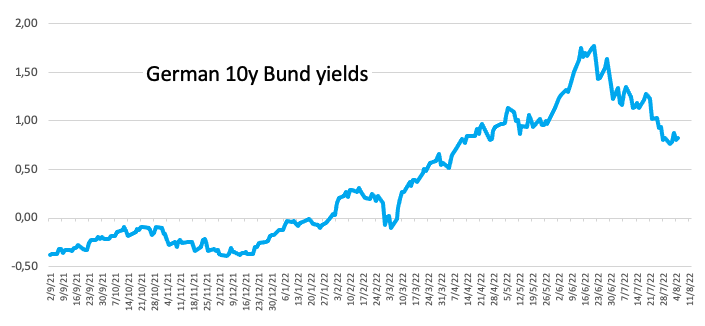
Indeed, the appetite for the risk-associated assets appears somewhat subdued on Friday, as usual cautiousness pre-NFP dominates the sentiment among market participants.
In the domestic data space, Italian Industrial Production contracted 2.1% MoM in June and 1.2% from a year earlier. In France, the Industrial Production expanded 1.4% MoM also in June and the trade deficit widened to €13.7B in the same month.
Other than the monthly labour market report, the US docket will include the Consumer Credit Change figures for the month of June and the speech by Richmond Fed T.Barkin.
What to look for around EUR
EUR/USD remains within a choppy range this week ahead of the key release of US Nonfarm Payrolls for the month of July.
Price action around the European currency, in the meantime, is expected to closely follow dollar dynamics, geopolitical concerns, fragmentation worries and the Fed-ECB divergence.
On the negatives for the single currency emerges the so far increasing speculation of a potential recession in the region, which looks propped up by dwindling sentiment readings among investors and the renewed downtrend in some fundamentals.
Eminent issues on the back boiler: Continuation of the ECB hiking cycle. Italian elections in late September. Fragmentation risks amidst the ECB’s normalization of monetary conditions. Impact of the war in Ukraine on the region’s growth prospects and inflation.
EUR/USD levels to watch
So far, spot is retreating 0.16% at 1.0228 and faces the next contention at 1.0096 (weekly low July 26) followed by 1.0000 (psychological level) and finally 0.9952 (2022 low July 14). On the other hand, the break above 1.0293 (monthly high August 2) would target 1.0404 (55-day SMA) en route to 1.0615 (weekly high June 27).
- Gold edges lower on Friday and erodes a part of the overnight gains to a one-month high.
- A modest USD strength turns out to be a key factor exerting some pressure on the metal.
- Recession fears, geopolitical tensions should limit losses ahead of the key US NFP report.
Gold attracts some sellers on Friday and erodes a part of the previous day's strong move up to the $1,795 region, or a one-month high. The XAU/USD remains depressed around the $1,785 zone through the first half of the European session and for now, seems to have snapped a two-day winning streak.
The US dollar regains some positive traction on the last day of the week, which is turning out to be a key factor exerting some downward pressure on the dollar-denominated gold. The modest USD uptick, meanwhile, could be attributed to some repositioning trade ahead of the closely-watched US monthly jobs data, due for release later during the early North American session.
In the meantime, subdued action around the US bond markets is likely to act as a headwind for the USD and lend support to the non-yielding yellow metal. Despite hawkish remarks by several Fed officials this week, investors continue pushing back against the idea of a larger rate hike at the September FOMC meeting. This, in turn, has been weighing on the US bond yields.
Apart from this, growing recession fears, along with China-Taiwan tensions over US House Speaker Nancy Pelosi's visit to the island, should limit the downside for the safe-haven gold. In fact, China on Thursday conducted missile strikes in the Taiwan Strait. The five missiles landed within Japan's exclusive economic zone and raises tensions in the region.
Investors might also refrain from placing aggressive bets and prefer to wait for a fresh catalyst from the US NFP report. The data will play a key role in influencing the near-term USD price dynamics and provide a fresh directional impetus to gold. This makes it prudent to wait for strong follow-through selling before confirming that the XAU/USD has topped out.
Technical levels to watch
Rates strategist and Senior Economist at ABN Amro offer their take on the August Bank of England (BOE) monetary policy decision.
Key quotes
“The Bank of England (BoE) raised its policy rate by 50bp, which was the biggest increase since 1994 and in line with our and consensus expectations. This brought the bank rate to 1.75% and serves as the sixth consecutive rate hike.”
“The vote split indicates that the MPC committee was almost fully aligned this time with 8-1 MPC members that voted for a 50bp rate increase.”
“During the press conference, BoE Governor Bailey highlighted the exceptional high uncertainty surrounding the BoE’s forecasts and as such, the BoE will follow the ECB and the Fed's path of setting policy ‘’meeting-by-meeting’’. “
“Bailey stated that the BoE has moved from a system of ‘’predictive forward guidance to a framework that is not predictive’’. Therefore, ‘all options are on the table’ for future meetings.”
“The August report offers a much darker economic outlook for the UK compared to the previous report published in May.”
“Inflation is now expected to peak at 13.3% in 2022Q4 and remain elevated for longer than anticipated, with inflation at 9.5% (vs 5.9% prev) in 2023Q3. “
- AUD/USD witnesses some selling on Friday and snaps a two-day winning streak.
- The emergence of some USD selling exerts some downward pressure on the pair.
- Recession fears, geopolitical tensions further weigh on the risk-sensitive aussie.
- The downside seems cushioned as the focus remains glued to the US NFP report.
The AUD/USD pair struggles to capitalize on its two-day-old recovery move from its lowest level since July 25 and edges lower on Friday. The pair remains on the defensive through the first half of the European session and is currently placed near the daily low, around the 0.6950-0.6945 region.
The US dollar regains some positive traction on the last day of the week, which turns out to be a key factor exerting downward pressure on the AUD/USD pair. Against the backdrop of growing recession fears, heightened geopolitical tensions after US House Speaker Nancy Pelosi's Taiwan visit, offer some support to the safe-haven greenback.
In fact, China on Thursday said that it conducted “precision missile strikes” in the Taiwan Strait as part of military exercises. The five missiles fired by China landed within Japan's exclusive economic zone and raises tensions in the region. Furthermore, China said that it will sanction Pelosi and bar her from entering the country.
Apart from this, an uptick in the US Treasury bond yields offers additional support to the buck amid some repositioning trade ahead of the key data risk. The closely-watched US monthly jobs report - popularly known as NFP - is scheduled for release later during the early North American session and would influence the USD price dynamics.
Against the backdrop of more hawkish remarks by several Fed officials this week, stronger US data would revive bets for a large rate hike move at the September FOMC meeting. This would be enough to boost the USD. Conversely, any disappointment would further fuel recession fears and act as a tailwind for the safe-haven buck. This, in turn, suggest that the path of least resistance for the AUD/USD pair is to the downside.
Technical levels to watch
China’s Foreign Ministry announced on Friday, “we will sanction US House of Representative Speaker Nancy Pelosi over the Taiwan visit.”
Key takeaways
"Ms. Pelosi had disregarded China’s concerns and resolute opposition to her visit to the self-ruled island, which Beijing claims."
"Ms. Pelosi was the highest-ranking US official to visit the self-governing island in 25 years. China claims Taiwan as its territory and opposes it having its own engagements with foreign governments."
"Ms. Pelosi’s visit is provocative and said it undermines China’s sovereignty and territorial integrity. Sanctions would be imposed on Pelosi and her immediate family."
Market reaction
The Chinese proxy and high-beta currency, the AUD, has come under moderate selling pressure on escalating US-China tensions. AUD/USD is trading at 0.6952, down 0.23% so far, as of writing. The S&P 500 futures have erased gains and turned slightly negative on the day.
Bank of England (BOE) Chief Economist Huw Pill is making some comments this Friday following the central bank’s policy announcements on ‘Super Thursday’.
Key quotes
You would expect housing market to cool, not expecting dramatic downturn.
We are trying to ensure there is an element of flexibility on interest rates.
We are not behind the curve on inflation.
If we get inflation to target interest rates will be a slightly positive premium to inflation.
Equilibrium level of interest rates is very uncertain.
If we get inflation to 2%, nominal interest rates will be broadly at that level.
We are in a long transition since global financial crisis with low interest rates.
There are risks on both sides.
Quantitative tightening will have a tightening effect.
Market reaction
GBP/USD is back in the red below 1.2150, little affected by the above comments. The spot is currently trading at 1.2140, down 0.12% on the day.
USD/CNH is still predicted to extend the 6.7350-6.8000 consolidation theme for the next week, comment FX Strategists at UOB Group Lee Sue Ann and Quek Ser Leang.
Key Quotes
24-hour view: “We expected USD to ‘trade sideways within a range of 6.7470/6.7700’ yesterday. USD subsequently traded between 6.7496 and 6.7678 before closing little changed at 6.7523 (-0.09%). The underlying tone has softened somewhat and USD is likely to edge lower. That said, any weakness is likely limited to a test 6.7400 (minor support is at 6.7450). On the upside, a break of 6.7660 would indicate the current mild downward pressure has eased.”
Next 1-3 weeks: “We continue to hold the same view as Wednesday (03 Aug, spot at 6.7750) where is USD is likely to trade between 6.7350 and 6.8000 for now.”
- The index reclaims part of the ground lost on Thursday near 106.00.
- US yields keep showing lack of traction at the end of the week.
- The US economy is expected to have added 250K jobs in July.
The greenback regains the smile and motivates the US Dollar Index (DXY) to reverse Thursday’s pullback and refocus on the 106.00 neighbourhood ahead of the release of July’s Nonfarm Payrolls later in the session.
US Dollar Index now looks to data
Following Thursday’s deep decline, the index managed to regain some composure and retake the upper hand, revisiting at the same time the 106.00 zone at the end of the week.
The daily rebound in the dollar comes amidst the muted performance of US yields across the curve so far. Yields have been kind of ignoring further hawkish messages from FOMC governors, who hinted at the idea that the normalization process is still far from over and centring the debate at the same time on the size of the September hike. On the latter, CME Group’s FedWatch Tool sees the probability of a 50 bps rate raise at just above 60% vs. nearly 40% when it comes to a 75 bps hike.
Additional data in the US docket will see the Unemployment Rate (3.6% exp.), Average Hourly Earnings (4.9% YoY exp.) and finally June’s Consumer Credit Change.
What to look for around USD
Despite the risk aversion ebbed in past days, the dollar remains bid vs. the risk complex and keeps the index underpinned around 106 on Friday.
The very-near-term outlook for the dollar has deteriorated somewhat in recent sessions, particularly following the latest US GDP figures and the prospects for further tightening by the Fed in the next months, which carry the potential to drag further the economy into the contraction territory.
Among the positives for the buck still emerge the Fed’s divergence vs. most of its G10 peers (especially the ECB) in combination with bouts of geopolitical effervescence and occasional re-emergence of risk aversion.
Key events in the US this week: Non-Farm Payrolls, Unemployment Rate, Consumer Credit Change (Friday).
Eminent issues on the back boiler: Hard/soft/softish? landing of the US economy. Escalating geopolitical effervescence vs. Russia and China. Fed’s more aggressive rate path this year and 2023. US-China trade conflict. Future of Biden’s Build Back Better plan.
US Dollar Index relevant levels
Now, the index is gaining 0.19% at 105.95 and a break above 107.42 (weekly high post-FOMC July 27) would expose 109.29 (2022 high July 15) and then 109.77 (monthly high September 2002). On the other hand, the next support emerges at 105.04 (monthly low August 2) seconded by 104.95 (55-day SMA) and finally 103.67 (weekly low June 27).
Mitul Kotecha, Head of Emerging Markets Strategy at TD Securities (TDS), provides his afterthoughts on the Reserve Bank of India (RBI) policy decision, announced earlier this Friday. The Indian central bank raised its policy repo rate by 50bps to 5.40% in a unanimous decision.
Key Quotes:
“The RBI also maintained its stance to "remain focused on withdrawal of accommodation". We expect the RBI to follow up with more moderate tightening ahead; next hike likely at its meeting at the end of September. We maintain our terminal rate expectation of 6.0% by Q1 2023.”
“There was no revision to the RBI's fiscal year inflation forecast of 6.7% (TD 7.0%) though we see upside risks to this forecast. We concur with the view that CPI will remain above the target range (2-6%) for a few more months, but to drop below the band into next year. RBI maintained its growth forecast of 7.2% for FY 23 (TD 7.5%).”
“Like other Asian currencies INR has benefitted from the recent drop in the USD. Having pulled back from a breach of USDINR 80.0, we continue to expect some consolidation in the near term. We expect IGB yields to drift lower as the RBI shifts to less aggressive tightening in the months ahead though foreign investors continue to remain shy of Indian bonds.”
- Silver oscillates in a narrow trading band above the $20.00 round-figure mark on Friday.
- The technical set-up favour bulls and supports prospects for a further appreciating move.
- A convincing break below the $19.20 area is needed to negate any near-term positive bias.
Silver struggles to gain any meaningful traction on Friday and remains confined in a narrow range through the early European session. The white metal is currently hovering in neutral territory and so far, has managed to hold above the $20.00 psychological mark.
From a technical perspective, any subsequent move up is likely to confront stiff resistance near the mid-$20.00s confluence. The said barrier comprises the 50-day SMA and the 50% Fibonacci retracement level of the $22.52-$18.15 downfall, which should now act as a key pivotal point.
Positive oscillators on hourly/daily charts, meanwhile, support prospects for an eventual breakout through the aforementioned confluence hurdle. Hence, a subsequent positive move could lift the XAG/USD towards the 61.8% Fibo. level, around the $20.85 area, en route to the $21.00 mark.
The momentum could further get extended towards the next relevant hurdle near the $21.40-$21.50 area before the XAG/USD eventually aims to reclaim the $22.00 mark. The latter coincides with the 100-day SMA, which if cleared decisively would be seen as a fresh trigger for bullish traders.
On the flip side, the weekly swing low, around the $19.80-$19.75 region, which coincides with the 38.2% Fibo. level now seems to act as immediate support. Any further decline is more likely to stall and find decent support near the 23.6% Fibo. level, around the $19.20 region.
Some follow-through selling, leading to a subsequent break below the $19.00 mark, would shift the bias back in favour of bearish traders. The XAG/USD could then fall to the $18.40 intermediate support en route to the YTD low, around the $18.15 region touched on July 14.
Silver daily chart
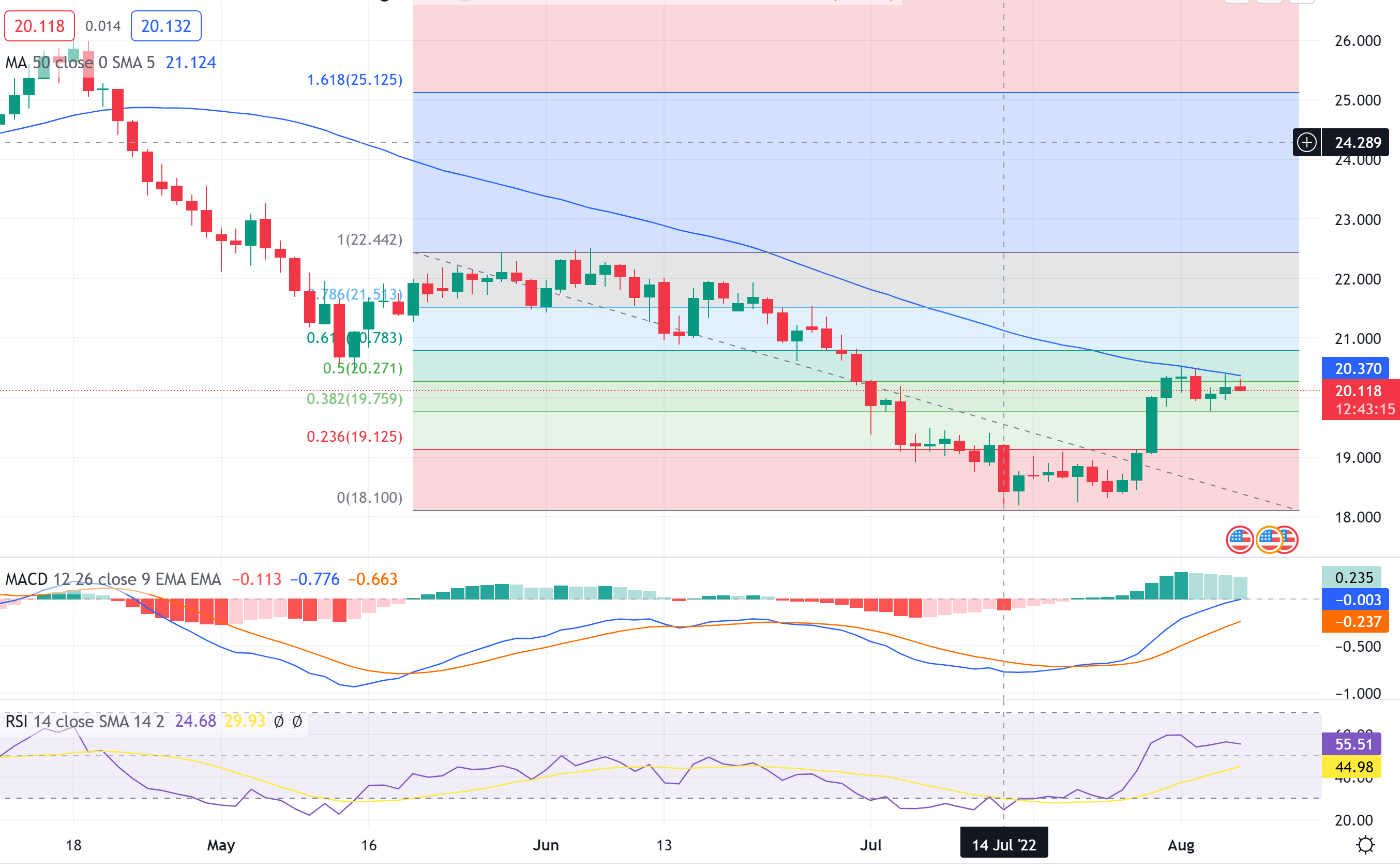
Key levels to watch
US Secretary of State Anthony Blinken is on the wires again, via Reuters, saying that “China's provocative actions a significant escalation.”
Additional quotes
United States has told China repeatedly it does not seek a crisis
Pelosi's visit was peaceful, no justification for China’s extreme response
No justification for China’s "extreme disproportionate and escalatory" response to Pelosi visit
Serious concerns that actions by Beijing will destabilise entire region
United states will stick by allies in region
We will fly, sail, operate wherever international law allows
United states will not be provoked by China’s actions
US will continue to make maritime transits through Taiwan strait
US defense secretary has ordered that USS Reagan will remain on station
We will continue to press the regime to release those unjustly detained in Myanmar
Russia visit to Myanmar flies in the face of Asian’s efforts to achieve peace
We stand in strong solidarity with Japan over China’s dangerous actions
We have open lines of communication with China
Reiterated position that China should not use Pelosi’s visit as pretext for provocative actions
Question of Pelosi’s visit came up when he spoke to China’s foreign minister Wang Yi in Bali last month
No possible justification for what China has done after Pelosi visit to Taiwan, have urged Beijing to cease such actions
Nothing inevitable about crisis, conflict; incumbent upon us and China to act responsibly
We won't take actions to provoke a crisis
We've said all along that the differences between mainland and Taiwan need to be resolved peacefully, not by force
Last thing countries in region want is to see differences resolved by force
What we don't want are efforts by any country including China or Russia to disrupt intl peace and security
Expects other countries will join US Indo-pacific economic framework
Market reaction
Markets remain cautiously optimistic so far this Friday, reflective of the 0.14% gains in the S&P 500 futures. Meanwhile, the US dollar index clings onto its recovery gains near 105.85, adding 0.15% on the day.
USD/JPY remains side-lined for the time being, note FX Strategists at UOB Group Lee Sue Ann and Quek Ser Leang.
Key Quotes
24-hour view: “Yesterday, we highlighted that ‘upward momentum has slowed and USD is unlikely to advance further’ and we expected USD to ‘trade between 133.10 and 134.50’. USD subsequently rose to 134.42 before staging a surprisingly sharp pullback (low of 132.75). Despite the sharp pullback, downward momentum has not improved by much. That said, there is room for USD to dip to 132.30. The next support at 131.80 is not expected to come under threat. On the upside, a breach of 134.10 (minor resistance is at 133.65) would indicate that the current mild downward pressure has eased.”
Next 1-3 weeks: “There is no change in our view from Wednesday (03 Aug, spot at 133.50). As highlighted, the recent USD weakness has ended. The current price actions are likely the early stages of a broad consolidation phase and USD is expected to trade between 131.30 and 135.60 for now.”
- GBP/USD attracts some dip-buying on Friday, though lacks bullish conviction.
- The BoE’s bleak economic outlook continues to act as a headwind for sterling.
- Modest USD strength also contributes to capping ahead of the US NFP report.
The GBP/USD pair reverses modest intraday losses and climbs back closer to the daily high during the early European session. The pair is currently trading just above the mid-1.2100s and might now be looking to build on the overnight bounce from the weekly low touched in reaction to the Bank of England's bleak economic outlook.
In fact, the UK central bank warned that a recession will begin in the fourth quarter and the economic downturn could last five quarters. Adding to this, the BoE said that the monetary policy is not on a pre-set path, suggesting that it might slow down the pace of the policy tightening. That said, the lack of any meaningful buying around the US dollar offers some support to the GBP/USD pair.
Despite more hawkish remarks by several Fed officials this week, investors have been pushing back against the idea of a larger interest rate hike at the September FOMC meeting. Apart from this, a positive tone around the equity markets undermines the safe-haven buck and assists the GBP/USD pair to attract some buying near the 1.2130 area, though the uptick lacks follow-through.
Traders now seem reluctant to place aggressive bets and prefer to wait on the sidelines ahead of the closely-watched US monthly jobs data, due later during the early North American session. The popularly known NFP report is expected to show that the economy added 250K jobs in July, down sharply from 372K in the previous month, and the unemployment rate remained steady at 3.6%.
Apart from this, investors will take cues from Average Hourly Earnings growth data. This will play a key role in influencing the near-term USD price dynamics and help determine the next leg of a directional move for the GBP/USD pair. In the meantime, spot prices seem more likely to remain confined in a range below the 1.2200-1.2210 strong resistance zone.
Technical levels to watch
Considering preliminary readings from CME Group for natural gas futures markets, traders scaled back their open interest positions by around 1.2K contracts on Thursday. In the same line, volume reversed three consecutive daily builds and dropped by around 84.3K contracts.
Natural Gas keeps targeting $9.75
The upside bias in prices of natural gas faltered once again around the $8.50 mark on Thursday and ended the session with moderate losses amidst declining open interest and volume. Against that, further losses look unlikely and leaves the door open for the continuation of the rebound with the immediate target at the 2022 high at the $9.75 mark per MMBtu (July 26).
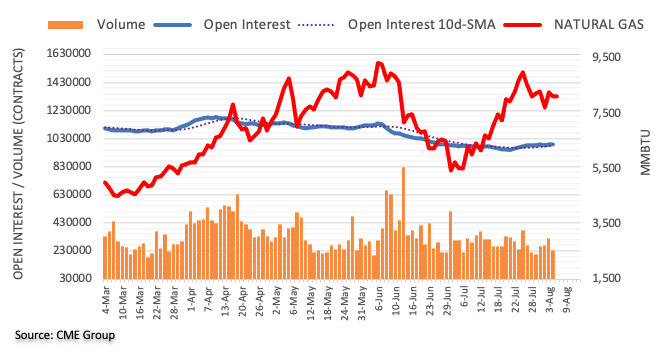
“Interest rates are not going back to where they were a pre-financial crisis,” Bank of England (BOE) Governor Andrew Bailey said on Friday.
Key quotes
We don't know what normal interest rates will be in future.
We don't think selling QE assets will have a big impact on market interest rates.
We are going to be dealing with impact of high inflation for some time.
Market reaction
GBP/USD is almost unfazed by the dovish remarks from BOE Governor Bailey. At the press time, cable is trading flat at 1.2160.
FX Strategists at UOB Group Lee Sue Ann and Quek Ser Leang now expect AUD/USD to trade between 0.6885 and 0.7035 in the near term.
Key Quotes
24-hour view: “We expected AUD to ‘trade sideways within a range of 0.6920/0.6970 yesterday’. AUD subsequently traded within a higher range than expected (0.6936/0.6988). The price actions still appear to be part of a consolidation and we expect AUD to trade between 0.6930 and 0.6985 for today.”
Next 1-3 weeks: “Two days ago (03 Aug, spot at 0.6900), we held the view that AUD is likely to trade with a downward bias towards 0.6840. Since then, AUD has not been able to make any headway on the downside. While our ‘strong resistance’ level at 0.6990 is not taken out (high of 0.6988 yesterday), downward momentum has fizzled out. From here, AUD is likely to consolidate and trade between 0.6885 and 0.7035.”
- USD/JPY regains traction on Friday and was supported by a combination of factors.
- The Fed-BoJ policy divergence and a positive risk tone undermine the safe-haven JPY.
- A modest USD uptick remains supportive, though bulls seem reluctant ahead of the NFP.
The USD/JPY pair attracts some buying near the mid-132.00s on Friday and reverses a part of the previous day's decline. The pair maintains its bid tone through the early European session and is currently trading around the 133.25 region, just a few pips below the daily high.
A big divergence in the monetary policy stance adopted by the Federal Reserve and the Bank of Japan, along with a positive risk tone, weighs on the safe-haven Japanese yen. Apart from this, a modest pickup in the US dollar demand turns out to be a key factor lending support to the USD/JPY pair.
It is worth recalling that the BoJ has repeatedly reiterated to stick to its ultra-easy policy settings and its commitment to keep the 10-year Japanese government bond yield around 0%. In contrast, several Fed officials hinted this week that more interest rates are coming in the near term.
Investors, however, have been pushing back against the idea of a larger rate hike at the September FOMC meeting. This, along with the recent fall in the US Treasury bond yields, is holding back the USD bulls from placing aggressive bets and keeping a lid on any meaningful gains for the USD/JPY pair.
Traders also seem reluctant and prefer to move on the sidelines ahead of the closely-watched US monthly jobs data, due later during the early North American session. The popularly known NFP report will influence the USD price dynamics and provide a fresh directional impetus to the USD/JPY pair.
Technical levels to watch
FX option expiries for August 5 NY cut at 10:00 Eastern Time, via DTCC, can be found below.
- EUR/USD: EUR amounts
- 1.0050 333m
- 1.0100 871m
- 1.0150 415m
- 1.0200 2.1b
- 1.0300 1.4b
- 1.0400 810m
- GBP/USD: GBP amounts
- 1.1965 564m
- 1.2010 300m
- 1.2100 590m
- 1.2200 239m
- 1.2275 303m
- USD/JPY: USD amounts
- 131.00 588m
- 131.75 411m
- 132.25 822m
- 132.50 797m
- 133.25 470m
- 134.00 2.1b
- 135.00 1.1b
- USD/CHF: USD amounts
- 0.9200 500m
- 0.9400 400m
- 0.9600 685m
- AUD/USD: AUD amounts
- 0.6800 918m
- 0.6900 494m
- 0.6950 498m
- 0.7000 532m
- 0.7200 1b
- USD/CAD: USD amounts
- 1.2600 1.1b
- 1.2800 1.6b
- 1.2900 1.1b
- 1.3000 813m
- NZD/USD: NZD amounts
- 0.5950 605m
- EUR/GBP: EUR amounts
- 0.8350 1.5b
- 0.8450 750m
- Iron licks wounds during the sixth loss-making week, steel prices seesaw around monthly high.
- Fears of weak demand from China joins central bank aggression to weigh on prices.
- Steady decline in Chinese steel inventories favors the industrial metal prices.
Metal prices struggle to defend the latest recovery moves as traders await the US employment data during early Friday morning in Europe.
That said, iron ore futures print mild gains while steel price seesaws around a monthly peak as traders consolidate recent moves.
Even so, iron ore braces for the sixth weekly fall in prices of the front-month September contract on the Singapore Exchange, up 4.3% around $110.30. The stated iron ore contract tested the lowest levels in nearly two weeks the previous day, to $104.70. Elsewhere, China's Dalian Commodity Exchange, the most-traded January 2023 contract advanced 0.9% to 711.50 yuan ($105.45) a tonne, said Reuters.
On the other hand, steel rebar prices on the Shanghai Futures Exchange rose 0.5% whereas hot-rolled coil and stainless steel gained 0.7% and 0.4% on a day by the press time.
A rebound in the steel margins previously prompted some of the producers to restart their manufacturing facilities. However, those manufacturing units couldn’t run at full capacity and continued to signal the supply gap, as per Reuters. The news also mentioned that steel stocks held by traders in 132 Chinese cities surveyed by Mysteel consultancy dropped 603,700 tonnes from last week to a six-month low of 20.3 million tonnes, as of Aug. 4. Inventories at 184 Chinese steel mills declined for the sixth week during July 28-August 3, to 4.76 million tonnes, Mysteel reported, per Reuters.
Talking about China, the ailing property sector, COVID-19 curbs, steel production cuts, and Sino-U.S. tensions over Taiwan are the key catalysts that keep metal buyers hopeful. However, broad recession fears exert downside pressure on metal prices.
Looking forward, the metal traders should pay attention to the risk catalysts and yields ahead of the US Nonfarm Payrolls (NFP) for July, expected 250K versus 372K prior, for clear directions.
Here is what you need to know on Friday, August 5:
The dollar weakened against its rivals amid falling US Treasury bond yields on Thursday but managed to regain its traction early Friday. Ahead of the all-important US July jobs report, the US Dollar Index posts modest daily gains near 106.00. The European docket will not be featuring any high-impact data releases and the market mood remains relatively upbeat with US stock index futures trading in positive territory. Meanwhile, the benchmark 10-year US Treasury bond yield moves sideways below 2.7%, allowing the greenback to stay resilient in the early European morning.
Nonfarm Payrolls Preview: High expectations set deal the dollar a blow, create buying opportunity.
On Thursday, the Bank of England (BOE) announced that it raised its policy rate by 50 basis points to 1.75% following its August policy meeting. In its revised projections, however, the BOE said that it expects the UK economy to tip into recession in the last quarter of the year. The gloomy economic outlook caused the British pound to suffer heavy losses and GBP/USD dropped to a daily low of 1.2065 before staging a rebound amid renewed dollar weakness in the second half of the day. At the time of press, the pair was moving sideways near 1.2150.
BOE Analysis: Brutally honest Bailey blasts the pound, why further falls are likely.
EUR/USD gained more than 50 pips on Thursday but failed to preserve its bullish momentum. Nevertheless, the pair continues to trade above 1.0200. The data from Germany showed earlier in the day that Industrial production expanded by 0.4% in June but this reading had little to no impact on the shared currency's valuation.
Gold extended its rally to a fresh monthly high amid falling US Treasury bond yields and came within a touching distance of $1,800. XAU/USD seems to have gone into a consolidation phase near $1,790 while waiting for the next catalyst.
US July Nonfarm Payrolls Preview: Analyzing gold's reaction to NFP surprises.
USD/JPY edges higher and trades above 133.00 early Friday after having closed deep in negative territory on Thursday. The data from Japan revealed in the early Asian session that the Leading Economic Index declined to 100.6 in June from 101.2 in May.
USD/CAD failed to capitalize on the broad dollar weakness as falling crude oil prices weighed on the commodity-sensitive loonie. The barrel of West Texas Intermediate, which lost nearly 10% this week, was last seen rising 1.8% on the day at $89.30, making it difficult for the pair to stretch higher. Later in the day, Statistics Canada is forecast to report that the Unemployment Rate rose to 5% in July from 4.9% in June.
Bitcoin closed the first four days of the week with small losses but recovered above $23,000 early Friday, rising nearly 3% on a daily basis. After having dipped below $1,600 on Thursday, Ethereum gained traction and climbed toward $1,700 on Friday.
Open interest in crude oil futures markets shrank by just 736 contracts on Thursday, partially reversing the previous daily build according to advanced prints from CME Group. Volume followed suit and dropped markedly by around 206.6K contracts.
WTI faces the next hurdle at the 200-day SMA
Prices of the WTI dropped to 6-month lows below the $90.00 mark per barrel on Thursday. The strong pullback was accompanied by diminishing open interest and volume, which initially rules out a deeper decline from current levels and instead allows a potential bounce in the very near term. An initial recovery is expected to target the 200-day SMA, today at $95.21.
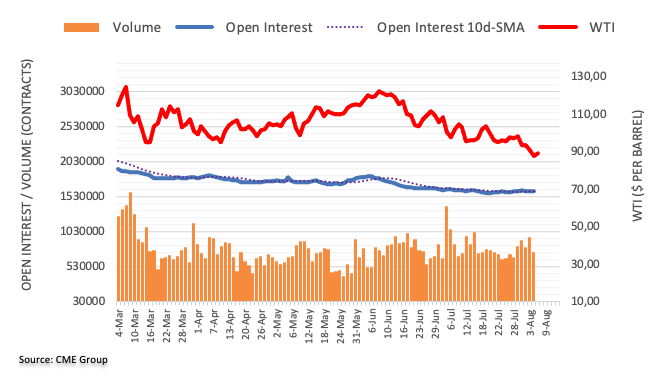
- EUR/USD consolidates the biggest daily gain in a week and renews intraday low of late.
- 21-DMA challenges bears amid steady RSI and bullish MACD signals.
- Monthly horizontal resistance guards immediate upside, sellers need to conquer 1.0095 to keep reins.
EUR/USD takes offers to refresh intraday low around 1.0225 after Germany’s Industrial Production release on early Friday morning in Europe. In doing so, the major currency pair eased below a monthly horizontal resistance line ahead of the key US employment report for July.
That said, the absence of oversold RSI and bullish MACD hint at the continuation of the EUR/USD pair’s latest weakness.
However, the 21-DMA support near 1.0160 seems to challenge the short-term downside of the pair. Following that, the recent swing low near 1.0090 will act as the last defense of EUR/USD buyers before inviting bears to challenge the yearly low near 0.9950.
Meanwhile, recovery moves may initially battle the monthly horizontal resistance line surrounding 1.0290.
Following that, a downward sloping resistance line from February and a 2.5-month-old horizontal resistance area, surrounding 1.0360-65, appears a tough nut to crack for the EUR/USD bulls.
Although the EUR/USD prices are likely to step back from 1.0365, successful trading beyond the same won’t hesitate to propel the bulls towards June’s peak of 1.0615.
EUR/USD: Daily chart
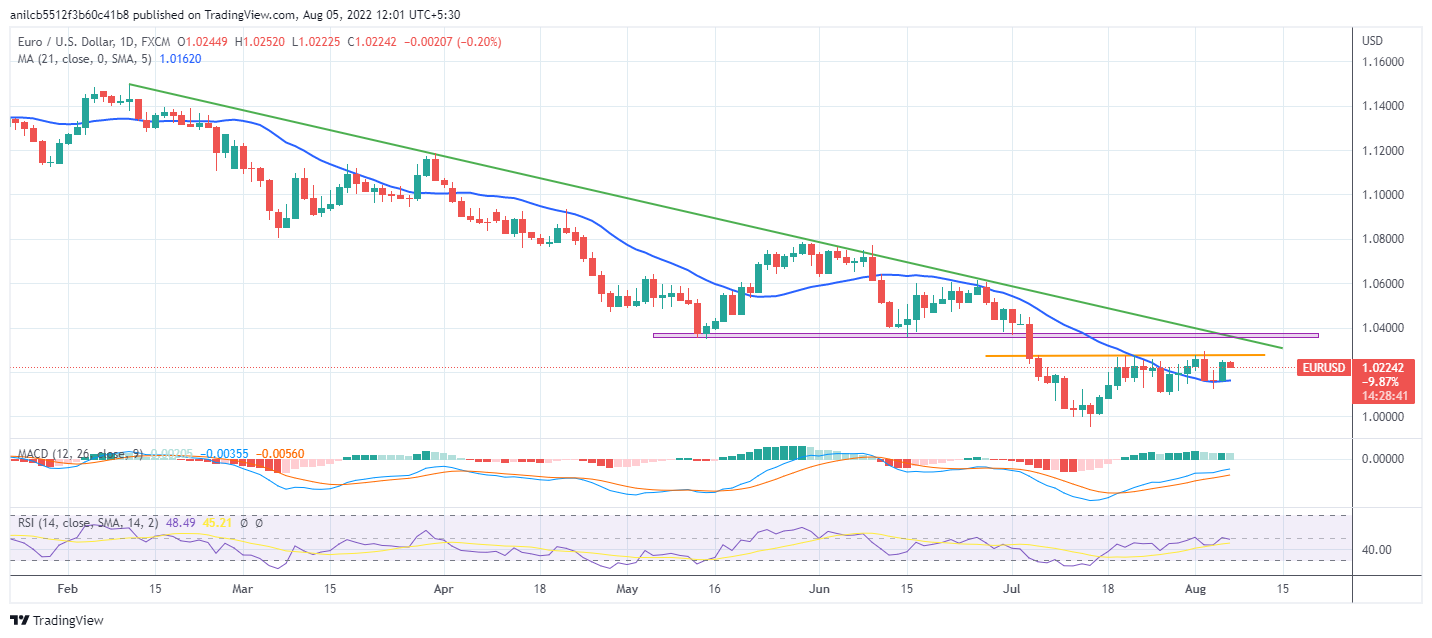
Trend: Further weakness expected
In the opinion of FX Strategists at UOB Group Lee Sue Ann and Quek Ser Leang, GBP/USD is now seen navigating the 1.2040-1.2255 range in the next few weeks.
Key Quotes
24-hour view: “We expected GBP to weaken yesterday but we were of the view that ‘the major support at 1.2040 is not expected to come into the picture’. The subsequent price actions did not turn out as we expected as GBP surged briefly to 1.2220, plunged to 1.2065 before snapping back up to end the day little changed at 1.2158 (+0.08%). The sharp swings have resulted in a mixed outlook. For today, GBP could continue to trade in a choppy manner, likely staying within yesterday’s broad range of 1.2065/1.2220.”
Next 1-3 weeks: “Our latest narrative was from Wednesday (03 Aug, spot at 1.2160) where GBP is in a consolidation phase and is likely to trade within a range of 1.2040/1.2255. Yesterday, GBP rose briefly to 1.2220, plunged to 1.2065 before rebounding to close little changed at 1.2158 (+0.08%). The price actions offer no fresh clues and we continue to hold the same view for now.”
CME Group’s flash data for gold futures markets noted open interest reversed four consecutive daily drops and went up by around 2.5K contracts on Thursday. On the other hand, volume shrank for the second session in a row, this time by just 870 contracts.
Gold now targets $1,800
Gold prices extended the recent recovery on Thursday amidst rising open interest. Against that, the precious metal remained on track to revisit the key area at the $1,800 mark per ounce troy.
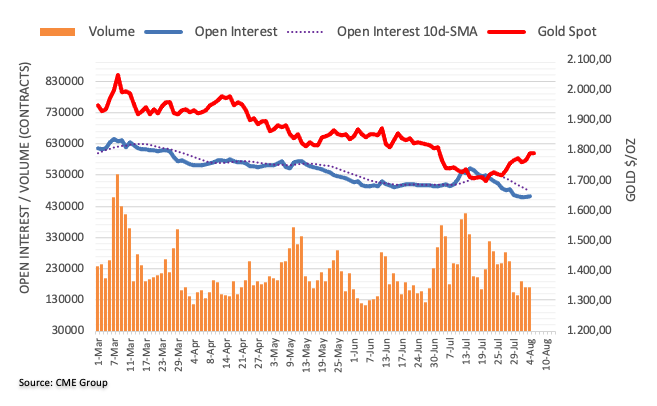
- Gold price remains sidelined within a choppy trading range, bulls struggle to keep reins around monthly high.
- US dollar rebound challenges the XAU/USD buyers ahead of the key US employment report.
- Chatters surrounding China, Taiwan and recession also entertain traders.
Gold price (XAU/USD) seesaws around the monthly top as traders depict the typical anxiety ahead of the key US jobs report on Friday. That said, the yellow metal seesaws near $1,788-95 area, around $1,791 by the press time of the early morning in Europe.
In addition to the pre-NFP caution, the market’s mixed concerns surrounding the global recession and the latest geopolitical headlines concerning Taiwan also contribute to the XAU/USD’s sluggish move. It’s worth noting that the options market flashes mixed signals and challenges the gold buyers.
The fears of a global economic slowdown seem to have ebbed amid the recent rebound in the US Treasury yields, which in turn propelled the US dollar and exert downside pressure on the gold price.
The US Dollar Index (DXY) snaps a two-day downtrend while printing mild gains around 106.00. The greenback gauge dropped during the last two days before tracing the yields to consolidate recent losses. It’s worth noting that the US 10-year Treasury yields stabilize around 2.069% after declining in the last two days. Even so, the US Treasury yields continued to portray the risk of recession as the difference between the 10-year and 2-year bond coupons remain the widest since 2000.
Elsewhere, geopolitical challenges emanating from the Taiwan Strait also challenge gold buyers as China reflects its dislike for US House Speaker Nancy Pelosi’s visit to Taipei. Recently, US Secretary of State Antony Blinken told an East Asia meeting, per West Official, that China’s reaction to US House Speaker Nancy Pelosi’s Taiwan visit had been "flagrantly provocative".
Talking about the mood in the options market, a one-month risk reversal (RR) of gold prices snaps a three-week downtrend on the weekly basis but drops for the third consecutive day if watched daily. It should be noted that the spread between the bullish and bearish bets, namely the call options and the put options, is known as the risk reversal (RR).
To sum up, gold prices remain sidelined but the negatives are more than the positives and hence today’s US employment report for July will be crucial for near-term directions. Should the employment data appear stronger, the US dollar rebound can extend and weigh on gold prices.
Technical analysis
Gold price seesaws between $1,788 and $1,795 as buyers and sellers jostle near the monthly high amid overbought RSI conditions.
That said, the quote’s pullback moves need validation from a three-day-old support line, near $1,787, before directing the XAU/USD bears towards the double bottom marked on Wednesday, as well as the 200-HMA, around $1,754-55.
Alternatively, an upside break of $1,795 will need to successfully cross the $1,800 round figure to please XAU/USD buyers.
Even so, a fortnight-old resistance line near $1,805 could restrict short-term gold price run-up.
Gold: Hourly chart

Trend: Pullback expected
Industrial Production in Germany unexpectedly rose in June, the official data showed on Friday, suggesting that the manufacturing sector activity is gaining its recovery momentum.
Eurozone’s economic powerhouse’s industrial output climbed by 0.4% MoM, the federal statistics authority Destatis said in figures adjusted for seasonal and calendar effects, vs. a -0.3% expected and 0.2% last.
On an annualized basis, German industrial production fell by 0.5% in June versus a -1.41% drop booked previously.
FX implications
The shared currency remains pressured towards 1.0200 on the mixed German industrial figures.
At the time of writing, EUR/USD is trading at 1.0229, down 0.13% on the day.
About German Industrial Production
The Industrial Production released by the Statistisches Bundesamt Deutschland measures outputs of the German factories and mines. Changes in industrial production are widely followed as a major indicator of strength in the manufacturing sector. A high reading is seen as positive (or bullish) for the EUR, whereas a low reading is seen as negative (or bearish).
- EUR/JPY is oscillating between 20- and 50-EMAs, which indicates a volatility contraction.
- An establishment above the downwards-sloping trendline has strengthened the eurozone bulls.
- For further upside, the asset needs to violate the 137.05-137.31 supply area.
The EUR/JPY pair is aiming gradually higher after a bullish open test-drive move in the Asian session. The cross is continuously facing barricades around the critical resistance of 136.50. On a broader note, the asset is scaling higher after printing a low of 133.39 on Tuesday, has added 2.60% and bulls are still gearing for a fresh rally.
Confident stability above the downward sloping trendline, on a four-hour scale, plotted from July 21 high at 142.33 has strengthened the shared currency bulls. However, the supply zone placed in a 137.05-137.31 range will act as a major resistance ahead.
The 50-period Exponential Moving Average (EMA) at 136.65 is restricting the eurozone bulls from scaling higher while the 20-MA at 136.00 is providing a cushion to the asset. An oscillation of an asset in a mid of 20 and 50-EMAs signals a volatility contraction.
Also, the Relative Strength Index (RSI) (14) has shifted into the 40.00-60.00 range, which indicates that the asset is awaiting a potential trigger for a meaningful move.
Should the asset violates the above-mentioned supply zone firmly, the eurozone bulls will drive the asset towards July 26 low at 138.13, followed by July 27 high at 139.51.
On the contrary, the yen bulls could regain strength if the asset drops below Thursday’s low at 135.66. An occurrence of the same will drag the asset towards Wednesday’s low and Tuesday’s low at 134.83 and 133.39 respectively.
EUR/JPY four-hour chart

A sustained advance in EUR/USD is likely on a break above the 1.0300 level, suggested FX Strategists at UOB Group Lee Sue Ann and Quek Ser Leang.
Key Quotes
24-hour view: “While we highlighted yesterday that ‘EUR is unlikely to weaken’, we expected it to ‘trade between 1.0130 and 1.0210’. However, EUR soared to 1.0253 before closing on a strong note at 1.0243 (+0.78%). Upward momentum is building and the chance for EUR to break the 1.0260 has increased. That said, the odds for a breach of the next major resistance at 1.0300 are not high for now. Support is at 1.0215 followed by 1.0185.”
Next 1-3 weeks: “We have expected EUR to consolidate for more than a week now. In our latest narrative from Wednesday (03 Aug, spot at 1.0165), we indicated that EUR is still in a consolidation phase and expected it to trade between 1.0100 and 1.0260. EUR rose to 1.0253 yesterday and shorter-term upward momentum is beginning to build. However, EUR has to break 1.0300 before a sustained advance is likely. The chance for EUR to break 1.0300 would remain intact as long as it does not move below the ‘strong support’ level (currently at 1.0140) within these 1 to 2 days.”
- USD/CAD extends the previous day’s rebound from weekly low ahead of the key US/Canada jobs report for July.
- US dollar tracks yields to consolidate recent losses, snaps two-day downtrend.
- Oil prices bounce off six-month low amid geopolitical concerns.
USD/CAD picks up bids to 1.2875 as buyers keep reins for the second consecutive day heading into Friday’s European session.
The Loonie pair’s latest gains could be linked to the US dollar’s rebound, as well as the market’s cautious optimism, ahead of the key US/Canada jobs report for July. In doing so, the quote also ignores the corrective pullback in prices of Canada’s main export item WTI crude oil from a six-month low.
That said, the US Dollar Index (DXY) snaps a two-day downtrend while printing mild gains around 106.00. The greenback gauge dropped during the last two days before tracing the yields to consolidate recent losses. It’s worth noting that the US 10-year Treasury yields stabilize around 2.069% after declining in the last two days. Even so, the US Treasury yields continued to portray the risk of recession as the difference between the 10-year and 2-year bond coupons remain the widest since 2000.
On the other hand, WTI crude oil prices rise 1.15% intraday while bouncing off the lowest levels since February, to $89.00 at the latest.
The recent gains of the US dollar, as well as the crude oil prices, could also be linked to the fears of fresh geopolitical challenges emanating from the Taiwan Strait as China reflects its dislike for US House Speaker Nancy Pelosi’s visit to Taipei. At the latest, US Secretary of State Antony Blinken recently told an East Asia meeting, per West Official, that China’s reaction to US House Speaker Nancy Pelosi’s Taiwan visit had been "flagrantly provocative".
Amid these plays, Wall Street closed mixed and the S&P 500 Futures print mild gains while taking rounds to the two-month high flashed the previous day, up 0.23% intraday around 4,162 by the press time.
Moving on, USD/CAD traders should be cautious as the US employment report is likely to flash comparatively weaker data, which in turn could defy the Fed hawks and weigh on the pair prices. However, a surprise increase in the headline Nonfarm Payrolls (NFP), expected 250K versus 372K prior, won’t hesitate to propel the greenback.
Also read: Nonfarm Payrolls Preview: High expectations set deal the dollar a blow, create buying opportunity
Technical analysis
Unless crossing the 21-DMA hurdle surrounding 1.2910, the USD/CAD buyers remain unconvinced.
- Aussie bulls are facing barricades around 50% Fibo retracement at 0.6983.
- The asset is expected to remain sideways in the 0.6890-0.7045 range.
- The 200-EMA has turned flat while the 50-EMA is overlapping with the asset prices.
The AUD/USD pair is displaying back and forth moves in a narrow range of 0.6945-0.6976 in the Asian session. The asset has turned sideways after a responsive buying action from a cushion below 0.6900. Usually, a responsive buying action indicates the initiation of significant longs by the market participants as they find the asset price a value bet.
On a four-hour scale, the aussie bulls are facing barricades around the 50% Fibonacci retracement (which is placed from June high at 0.7283 to July 14 low at 0.6707) at 0.6983. This has pushed the asset into a charted territory. The asset will consolidate in a 0.6890-0.7045 range ahead.
The 200-period Exponential Moving Average (EMA) at 0.6930. Also, the 50-EMA at 0.6952 is overlapping with the asset prices, which signals a consolidation ahead.
Adding to that, the Relative Strength Index (RSI) (14) has shifted into the 40.00-60.00 range, which indicates that the asset is awaiting a potential trigger for a meaningful move.
A decisive move above the six-week high at 0.7047 will send the major towards the round-level resistance of 0.7100, followed by May 31 high at 0.7204.
Alternatively, a downside break of the above-mentioned consolidation, which is in a 0.6890-0.7045 range will drag the asset towards a 23.6% Fibo retracement at 0.6823. A slippage below 23.6% Fibo retracement will trigger the downside risk to July 5 low at 0.6761.
AUD/USD four-hour chart
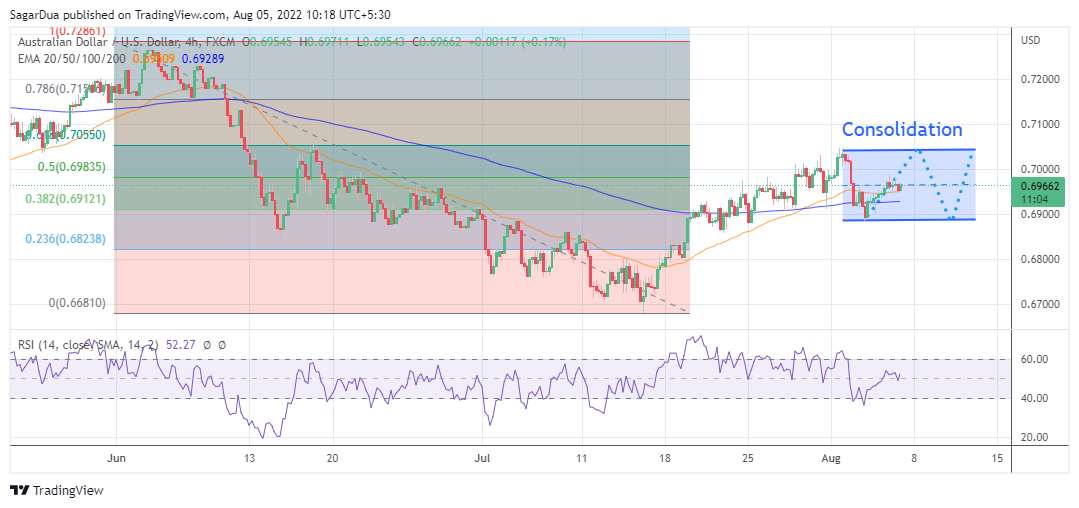
US Secretary of State Blinken: China had sought to intimidate not only Taiwan, but neighbors too
more to come
- USD/INR keeps pullback from weekly high on RBI’s action.
- RBI crossed the market forecast to increase Repo rate to 5.4%.
- US dollar tracks yields to consolidate the biggest daily loss in a week by snapping two-day downtrend.
- US NFP, China headlines and recession talks are the key for fresh impulse.
USD/INR takes offers to refresh intraday low around 78.95 on the Reserve Bank of India’s (RBI) Monetary Policy Meeting announcements during early Friday morning in Europe.
The Indian rupee (INR) pair dropped after the RBI unveiled 50 basis points (bps) of an increase in the benchmark Repo Rate to 5.40% after the latest monetary policy meeting.
Following the announcement, RBI Governor Shaktikanta Das mentioned that the domestic economy faces headwinds from global forces. The RBI Boss also announced a downward revision to the Indian Gross Domestic Product (GDP) figures while saying, “Inflation trajectory continues to be heavily contingent about geopolitical developments.”
Ahead of the RBI verdict, the Indian rupee’s volatility, measured in terms of the daily close-to-close, reached its highest level since late March per Reuters. The news also stated that The RBI is widely expected to raise the repo rate as it continues its battle to control inflation. Economists, however, differ on the size of the rate hike that the RBI will deliver as the central bank aims to strike the right balance between inflation and growth.
Reuters quotes Anindya Banerjee, vice president at Kotak Securities while saying, “Historically, whenever the implied volatility in options has been priced higher ahead of the policy, there tends to be lower-than-expected volatility in the pair (USD/INR)."
“India's record trade deficit in July has raised considerable concerns over its external balances and might force the Reserve Bank of India to rethink its strategy of persistent intervention to slow the rupee's depreciation,” mentioned Reuters.
In addition to the RBI moves, the market’s fears of recession and cautious mood ahead of the key US employment data from the US and Canada also appear to keep the USD/INR bulls hopeful. That said, the Reserve Bank of Australia’s (RBA) quarterly Monetary Policy Statement backed the market’s recession fears the Bank of England (BOE) conveyed the UK recession in late 2022. On the same line were comments from Cleveland Fed President Loretta Mester who mentioned recession risks have increased in the US.
It should be noted that the US 10-year Treasury yields stabilize around 2.069% after declining in the last two days. Even so, the US Treasury yields continued to portray the risk of recession as the difference between the 10-year and 2-year bond coupons remain the widest since 2000.
Additionally, news that China’s missiles landed on Japan’s exclusive economic zones raised market fears. The dragon nation conducted heavy military drills near the Taiwan border after US House Speaker Nancy Pelosi visited Taipei against Beijing’s warning.
While portraying the mood, Wall Street closed mixed and the S&P 500 Futures print mild gains while taking rounds to the two-month high flashed the previous day, up 0.23% intraday around 4,162 by the press time.
Having witnessed the initial reaction to the RBI moves, USD/INR traders should wait for the US Nonfarm Payrolls (NFP) for July, expected 250K versus 372K prior, for clear directions.
Technical analysis
Unless providing a daily closing beyond 79.65, USD/INR buyers should remain cautious. However, the pullback moves may remain elusive unless refreshing the monthly low near 78.45.
- Asian equities are performing well as oil prices have slipped sharply.
- The RBI is expected to announce a 50 bps rate hike to combat soaring inflation.
- The release of the US NFP will provide a decisive move to the DXY.
Markets in the Asian domain have carry-forwarded their optimism on Friday as oil prices are nose-diving after various supply catalysts. Oil prices printed a low of $87.00 on Thursday after six months as higher oil stock buildup in the last week reported by the Energy Information Administration (EIA) and a promise of supplying more oil into the global supply by the OPEC+ have trimmed supply worries.
Also, the ongoing Sino-US tensions over Taiwan could underpin sanctions on China, which could trigger demand worries. The collaboration of supply triggers and demand worries has weighed pressure on oil prices. It is worth noting that oil carries a significant portion of total imports made by Asian nations. Therefore, demand worries in China, which is a leading oil consumer, are sufficient to impact oil prices. Now, lower oil prices will result in a lower fiscal deficit for the countries in Asia.
At the press time, Japan’s Nikkei225 gained 0.83%, China A50 added 0.16%, Hang Seng shows an uptick of 0.18%, and Nifty50 climbed 0.35%.
Indian indices are likely to dance to the tunes of the Reserve Bank of India (RBI) as the central bank will announce the interest rate decision taken in the two-day monetary policy committee (MPC). RBI Governor Shaktikanta Das is expected to hike the repo rate by 50 basis points (bps). A rate hike of 50 bps will push the repo rate to its pre-pandemic levels at 5.40%, which were earlier recorded in August 2019.
Meanwhile, the mighty US dollar index (DXY) is awaiting the release of the US Nonfarm Payrolls (NFP) for a decisive move. The job additions in July are seen at 250k, lower than the prior release of 372k. While the jobless data is seen unchanged at 3.6%.
- GBP/USD prints mild losses while keeping the pullback from support-turned-resistance.
- 50-SMA guards immediate upside, 1.2080 appears a tough nut to crack for bears.
- MACD signals, sustained break of three-week-old ascending trend line keep sellers hopeful.
GBP/USD licks its wounds around 1.2150 during early Friday morning in Europe. In doing so, the Cable pair retreats from the 50-SMA while fading the bounce off the 200-SMA.
The quote broke an upward sloping trend line from mid-July the previous day and stays below the same since then. The sustained trading below the previous key support joins downbeat MACD signals and a pullback from the 50-SMA to favor bears.
However, a convergence of the 200-SMA and a 50% Fibonacci retracement of the June-July downside, near 1.2080, appears strong support to crack for the bears before convincing the markets.
It’s worth noting that the early July swing high near 1.2055 can act as a validation point for the GBP/USD south-run targeting the multi-month low marked on July 14, at 1.1760.
Alternatively, recovery moves initially jostle with the 50-SMA level of 1.2150 before challenging the previous support line near 1.2170.
Even if the GBP/USD prices manage to cross the 1.2170 hurdle, a downward sloping resistance line from June 16, close to 1.2285, could challenge the bulls.
GBP/USD: Four-hour chart

Trend: Further weakness expected
- EUR/USD has been dragged to near 1.0230 as DXY is picking bids ahead of the US NFP.
- US job market will increase at a diminishing rate as employment levels have reached their full capacity.
- The downbeat Retail Sales and German Factory Orders indicate a slowdown in Eurozone ahead.
The EUR/USD pair has given a downside break of the inventory distribution formed in a narrow range of 1.0243-1.0254 in early Tokyo and has corrected to near 1.0230. The major is displaying exhaustion in the upside momentum and is likely to extend its correction as the US dollar index (DXY) has attempted a rebound after printing a low of 105.70 on Thursday.
As per the market consensus, the additional jobs created in the month of July may trim to 250k against the prior release of 372k. No doubt, rising interest rates have compelled the US corporate players to invest with such precautions. Costly dollars have forced them to move further with the safest investments only. Therefore, a slump in job creation was highly expected.
In spite of that, the DXY is performing well ahead of the labor market data. As investors are aware of the fact that the US economy is maintaining full employment levels consecutively for the past six months. Therefore, room for more employment generation is less and an increment in jobs with a decreasing rate should be welcomed by the market participants.
On the eurozone front, a slump in the overall demand is becoming a major concern for the shared currency bulls. Earlier, the Retail Sales data landed at -3.7%, lower than the expectations of -1.7% and the prior release of 0.4%. In times, when price pressures are sky-rocketing, the Retail Sales data should have reported an uptick, however, a slump in the same indicates that the overall demand is extremely poor.
Now, the downbeat German Factory Orders data has bolstered the slowdown claims. The economic data has squeezed by 0.4% vs. the expectation of a squeeze by 0.8% and the prior squeeze of 0.2% on a monthly basis.
- USD/IDR pauses three-day uptrend after upbeat prints of Indonesia Q2 GDP.
- Yields underpin US dollar rebound ahead of US NFP.
- Indonesia palm oil prices struggle but coal manages to keep rupiah buyers hopeful.
USD/IDR takes offers to refresh intraday low around 14,900 on upbeat Indonesia Q2 Gross Domestic Product (GDP) during Friday’s Asian session. Even so, the US dollar rebound amid the pre-NFP anxiety challenges the pair buyers.
That said, Indonesia’s second quarter (Q2) GDP was up 5.44% from a year earlier, showing the fastest growth rate in a year, according to Statistics Indonesia data. The GDP figures crossed 5.17% market forecasts and 5.01% prior.
“Prices of palm oil, one of the country's top export products, have plunged in recent months, but Indonesian coal prices are still hovering around record highs due to strong demand from such markets as Europe,” said Reuters following the data release. The news also mentioned that Indonesia's central bank (Bank Indonesia) said last month the rise in full-year 2022 GDP from 2021 would be at the lower end of the range of 4.5% to 5.3%. It previously forecast growth in the middle of that range.
Elsewhere, the US 10-year Treasury yields stabilize around 2.069% after declining in the last two days. Even so, the US Treasury yields continued to portray the risk of recession as the difference between the 10-year and 2-year bond coupons remain the widest since 2000. However, Wall Street closed mixed and the S&P 500 Futures print mild gains while taking rounds to the two-month high flashed the previous day, up 0.23% intraday around 4,162 by the press time.
Other than the pre-NFP anxiety and recession woes, news that China’s missiles landed on Japan’s exclusive economic zones raised market fears and challenge USD/IDR bears. The dragon nation conducted heavy military drills near the Taiwan border after US House Speaker Nancy Pelosi visited Taipei against Beijing’s warning.
Moving on, USD/IDR bears are likely to witness hardships unless the US data disappoint traders. Forecasts suggest that the US Nonfarm Payrolls (NFP) for July could ease to 250K versus 372K prior.
Technical analysis
Given the successful rebound from the 50-day EMA, USD/IDR appears capable of breaking the immediate hurdle surrounding 15,000 round figure ahead of July’s peak surrounding 15,030.
- NZD/USD has failed to defend its intraday low after a modest pullback.
- Fed policymaker has painted a hawkish picture for the rest of the year.
- Kiwi’s downbeat employment data could backfire later.
The NZD/USD has slipped back to its intraday low at around 0.6286 after a mild pullback. The US dollar index (DXY) is advancing higher right from the opening tick. On a broader note, the asset corrected to near 0.6280 after facing barricades above 0.6310 in the late New York session. A less confident rally above 0.6310 as an attempt to surpass the two-day high has bolstered the odds of further correction ahead.
The DXY is gaining strength as the Federal Reserve (Fed) policymaker has painted a hawkish picture ahead. Cleveland Fed President Loretta J. Mester, on Thursday, cited that the policy tightening measures should not be halted by the Fed without recording downward signs in the inflation rate for months. The Fed should raise interest rates to above 4% in order to bring inflation back down to 2% target. Therefore, the interest should see the continuation of elevation this year and for the next half year.
In today’s session, the release of the US Nonfarm Payrolls (NFP) will be of utmost importance. A report from JP Morgan on US labor market data indicates that the US economy has created 200k jobs in the month of July. No doubt the labor market has remained extremely tight in the US and now there is less room for further job creation.
On the kiwi front, Stats NZ reported that the Unemployment Rate increased to 3.3% from the estimates of 3.1% and the prior release of 3.2% in the second quarter. Also, the Employment Change for the second quarter has landed at 0%, significantly lower than the estimates of 0.4% and the prior print of 0.1%.
The bill known as the Inflation Reduction Act, introduced last week by Senate Majority Leader Chuck Schumer and Democratic Senator Joe Manchin is likely to be passed via reconciliation and voted on Saturday, per Reuters.
Key takeaways
“Democratic US Senator Kyrsten Sinema said on Thursday she agreed to "move forward" on a $430 billion drug pricing, energy and tax bill, subject to a Senate arbiter's approval of the bill, which Democrats intend to pass over Republican objections.”
“The bill known as the Inflation Reduction Act, introduced last week by Schumer and Democratic Senator Joe Manchin, represents a key priority for Democrats and President Joe Biden.”
“With the 100-seat Senate split 50-50, Democrats plan to pass the bill without Republican support through a parliamentary process known as reconciliation.”
Market reaction
The US dollar index clings to minor recovery gains on the above headlines, trading at 105.88, up 0.18% on the day, as of writing.
- Gold price has failed to recapture the psychological resistance of $1,800.00.
- The DXY is gaining strength despite the downbeat expectations for the US NFP.
- JP Morgan has slashed the consensus for the US NFP to 200k.
Gold price (XAU/USD) has slipped below $1,790.00 after failing to punch the psychological resistance of $1,800.00 in the Asian session. The precious metal formed a short-lived double top and a slight correction is highly expected by the market participants.
Meanwhile, the US dollar index (DXY) has displayed a stellar performance after the open despite the downbeat estimates for the US labor market data. After the consensus of 250k job addition in the month of July, economists at JP Morgan predict the US Nonfarm Payrolls (NFP) to come in weaker at 200K in July’s labor market report. In the month of June, the US economy added 372k jobs in the labor market. A continuous slash in job creation data is advocating severe pressure on the labor market. However, the Unemployment rate will remain stable at 3.6%.
Rising interest rates and their multiplier effects have triggered downside risks in the labor market activities. The corporate players are unable to invest unhesitatingly due to costly dollars. Therefore, lower investment opportunities are unable to accelerate the employment generation process.
Gold technical analysis
On a four-hour scale, the gold price has faced barricades while attempting a break of the Rising Channel on the upside. The upper portion of the above-mentioned chart pattern is plotted from July 22 high at $1,739.37 while the lower portion is placed from July 21 low at $1,681.87.
The precious metal is confidently established above the 50-and 200-period Exponential Moving Averages (EMAs) at $1,759.62 and $1,765.06 respectively, which adds to the upside filters.
Also, the Relative Strength Index (RSI) (14) is holding itself in the bullish range of 60.00-80.00, which indicates that the bullish momentum is still intact.
Gold four-hour chart
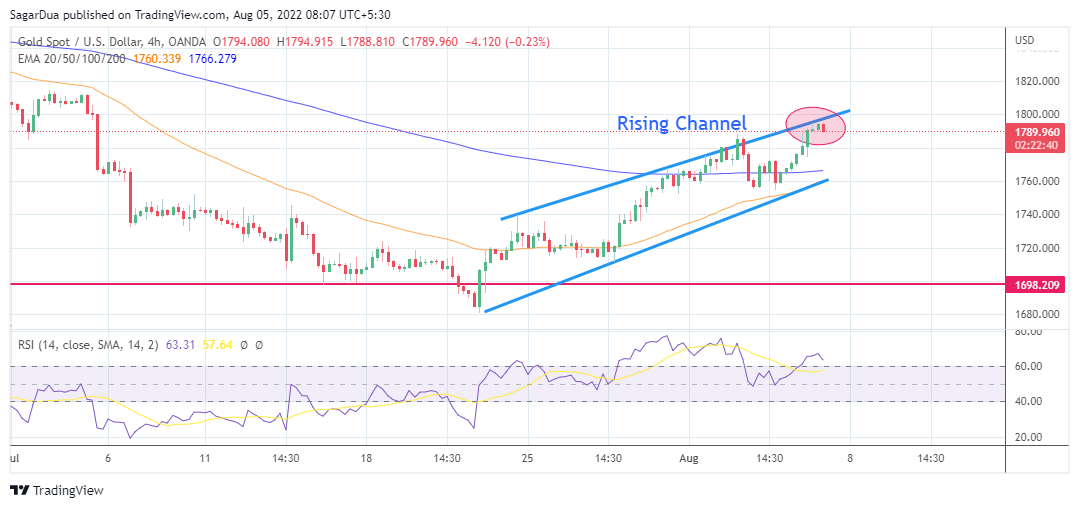
- USD/JPY remains mildly bid while consolidating the previous day’s losses amid pre-NFP anxiety.
- Japan’s household spending grew, real wages eased in June.
- Yields snap two-day downtrend but the 10-year, 2-year inversion portray economic fears.
- China’s missiles landed on Japan’s exclusive economic zone and propelled geopolitical fears.
USD/JPY seesaws around the intraday high of 133.35, near 133.10 by the press time, as firmer Treasury yields join mixed Japan data to recall buyers after the previous day’s fall. It’s worth noting that the cautious mood ahead of the US monthly employment report also seemed to have favored the yen pair’s rebound.
That said, Japan’s Households Spending grew 1.5% MoM and 3.5% YoY in June versus 0.2% and 1.5% marked forecasts. Further, Labor Cash Earnings rose to 2.2% YoY during the stated month compared to 2.1% expected. It should be noted, however, that the read wages eased to -0.4% YoY in June. Given the mixed data, the Bank of Japan (BOJ) is more likely to continue with its ultra-easy monetary policy.
Elsewhere, the US Initial Jobless Claims rose to 260K for the week ended on July 30 versus 254K prior and 259K expected. Further, job cuts eased and German Factory Orders improved while the US Goods and Services Trade Balance improved to $-79.6B versus $-80.1B market consensus and $-84.9B revised prior.
It should be noted that the US 10-year Treasury yields stabilize around 2.069% after declining in the last two days. Even so, the US Treasury yields continued to portray the risk of recession as the difference between the 10-year and 2-year bond coupons remain the widest since 2000.
In addition to the yields, news that China’s missiles landed on Japan’s exclusive economic zones raised market fears. The dragon nation conducted heavy military drills near the Taiwan border after US House Speaker Nancy Pelosi visited Taipei against Beijing’s warning.
Against this backdrop, Wall Street closed mixed and the S&P 500 Futures print mild gains while taking rounds to the two-month high flashed the previous day, up 0.23% intraday around 4,162 by the press time.
Looking forward, USD/JPY traders should pay attention to the risk catalysts and yields ahead of the US Nonfarm Payrolls (NFP) for July, expected 250K versus 372K prior, for clear directions.
Also read: Nonfarm Payrolls Preview: High expectations set deal the dollar a blow, create buying opportunity
Technical analysis
USD/JPY seesaws between the 50-DMA and the 100-DMA, respectively around 134.80 and 130.65 amid sluggish markets.
| Raw materials | Closed | Change, % |
|---|---|---|
| Silver | 20.181 | 0.64 |
| Gold | 1791.14 | 1.45 |
| Palladium | 2058.57 | 2.05 |
Japan’s Industry Minister Koichi Hagiuda said on Friday that they “will continue to look to Australia for stable LNG supply despite potential curb of LNG exports by Australia.”
Additional quotes
“Asking Mitsui and Mitsubishi to think positively to apply for a stake in new Russian entity to replace sakhalin-2 project.”
“Still unclear about details of conditions for Japanese trading houses to apply for a stake in new Russian entity to take over sakhalin-2 project.“
“Not aware of any request by the Russian side to seek additional investment or financial burden from Japanese trading houses to join the new Russian entity.”
Market reaction
USD/JPY was last seen trading at 133.17, up 0.24% on the day amid a tepid US dollar bounce and ahead of the US NFP.
- Market sentiment dwindles as recession woes join pre-NFP anxiety.
- S&P 500 Futures grind higher at multi-day top, yields snap two-day downtrend.
- BOE, RBA and Fedspeak keep economic slowdown fears on the table.
- China-inspired geopolitical concerns also challenge the risk-on mood.
Global markets remain sluggish, with a pause in bond buying, as traders await the all-important US jobs report for July during Friday’s Asian session. It’s worth noting that the fears of economic slowdown and tension surrounding Taiwan are extra catalysts that weigh on the market sentiment.
Even so, S&P 500 Futures print mild gains while taking rounds to the two-month high flashed the previous day, up 0.23% intraday around 4,162 by the press time. Also, the US 10-year Treasury yields stabilize around 2.069% after declining in the last two days. Even so, the US Treasury yields continued to portray the risk of recession as the difference between the 10-year and 2-year bond coupons remain the widest since 2000.
Earlier in the day, the Reserve Bank of Australia’s (RBA) quarterly Monetary Policy Statement backed the market’s recession fears while tracking the Bank of England’s (BOE) moves. That said, the Bank of England (BOE) conveyed the UK recession in late 2022. On the same line were comments from Cleveland Fed President Loretta Mester who mentioned recession risks have increased in the US.
It should be noted, however, that the recently firmer data from Europe, the latest one being the German Factory Order, joins the cautious tone of the major central bankers to help the equity buyers in keeping control. JP Morgan cites short covering moves by the retail investors as the catalyst behind the recently firmer equities.
That said, the US Initial Jobless Claims rose to 260K for the week ended on July 30 versus 254K prior and 259K expected. Further, job cuts eased and German Factory Orders improved while the US Goods and Services Trade Balance improved to $-79.6B versus $-80.1B market consensus and $-84.9B revised prior.
Given the mixed market performance, mainly the mildly bid equities in contrast to the pessimism, the traders should wait for the US Nonfarm Payrolls (NFP) for July, expected 250K versus 372K prior, for clear directions. Also important to watch will be the global reaction to China's strong military drills near Taiwan.
Also read: Nonfarm Payrolls Preview: High expectations set deal the dollar a blow, create buying opportunity
- AUD/USD remains sidelined after rising for the last two days.
- RBA downgrades economic growth forecasts, revises up inflation predictions in Monetary Policy Statement.
- US dollar’s corrective pullback ahead of NFP tracks recently firmer yields to challenge AUD/USD bulls.
- Headlines surrounding China, US NFP will be important for clear directions.
AUD/USD struggles to justify the Reserve Bank of Australia’s (RBA) quarterly Monetary Policy Statement, generally called MPS or SoMP, during Friday’s Asian session. That said, the Aussie pair remains sidelined at around 0.6970, pausing the two-day uptrend amid the cautious mood ahead of the US Nonfarm Payroll (NFP).
RBA warns that the economy will slow sharply as inflation soars, in its quarterly MPS. “Forecasts for economic growth this year were slashed by a full percentage point to 3.25%, while 2023 and 2024 were trimmed by around a quarter point to 1.75%,” said Reuters. The news also adds that the RBA has had to lift its forecast peak for headline inflation to 7.75%, when as recently as May it had tipped 5.9%.
Also read: RBA Statement: RBA jacks up its forecasts for inflation
Other than the RBA’s SoMP, the rebound in the US Treasury yields could also be linked to the AUD/USD pair’s latest retreat. That said, the US 10-year Treasury yields stabilize around 2.069% after declining in the last two days. Even so, the US Treasury yields continued to portray the risk of recession as the difference between the 10-year and 2-year bond coupons remain the widest since 2000.
Also portraying the risks of economic slowdown was the Bank of England’s (BOE) open acceptance of the recession in late 2022, as well as Cleveland Fed President Loretta Mester’s comments that mentioned recession risks have increased in the US.
Amid these plays, Wall Street closed mixed and the S&P 500 Futures remain directionless at the latest.
Having witnessed the initial reaction to the RBA’s MPS, AUD/USD traders may witness the lackluster day amid the pre-NFP trading lull. That said, the expected weakness in the US job numbers for July could help the AUD/USD to extend the previous day’s gains.
Technical analysis
A downward sloping resistance line from April 20 and 100-day EMA, close to 0.7025 and 0.7040 in that order, lures AUD/USD buyers unless the quote drops below a four-month-old previous support line, around 0.6875 by the press time.
The Reserve Bank of Australia's Monetary Policy Statement is out as follows offering updates in this quarterly release:
Reuters reports that Australia's central bank on Friday warned inflation was heading to three-decade highs requiring further hikes in interest rates that would slow growth sharply, making it tough to keep the economy on an "even keel".
''In its quarterly Statement on Monetary Policy, the Reserve Bank of Australia (RBA) jacked up its forecasts for inflation, downgraded the outlook for growth and foreshadowed an eventual rise in unemployment.
Yet even with further increases in rates, inflation was not expected to return to the top of its 2-3% target range until the end of 2024, pointing to a long period of pain ahead.''
"It is seeking to do this in a way that keeps the economy on an even keel," said RBA Governor Philip Lowe in the introduction to the 66-page statement.
"The path to achieve this balance is a narrow one and subject to considerable uncertainty."
Key notes
- Ready to do what is necessary to bring inflation back to 2-3% band.
- Seeking to restrain inflation while keeping economy on an even keel, this is a narrow path.
- Board expects to take further steps to normalise policy, but not on a pre-set path.
- Rate rises necessary to create more sustainable balance between demand and supply.
- Risk that high inflation gets built into wage and price setting behaviour.
- Inflation broad based but medium, long-term inflation expectations remain anchored.
- Rising cost of living, higher rates and falling house prices to weigh on economy.
- RBA downgrades outlook for economic growth, revises inflation forecasts sharply higher.
- Forecasts based on analyst, market pricing assume rates reach 3% by end 2022, decline a little by end of 2024.
- CPI inflation seen at 7.75% end 2022, 4.25% end 2023 and 3% end 2024.
- Trimmed mean inflation seen at 6% end 2022, 3.75% end 2023, 3% end 2024.
- GDP growth seen at 3.25% end 2022, 1.75% end of 2023, 2024.
- Unemployment seen at 3.25% end 2022, 3.5% end 2023, 4% end 2024.
- Wage price index seen at 3.0% end 2022, 3.6% end 2023, 3.9% end 2024.
- Around 60% of firms in liaison program expect wages to be high over year ahead.
- Many employers report they intend to increase headcount further but finding it hard to get workers.
- Risks to the global outlook are skewed to the downside given synchronised policy tightening.
AUD/USD update
As per the pre-event technical analysis, AUD/USD Price Analysis: Bulls and bears battle it out at critical hourly support, the bulls are moving in at a key hourly level of support:
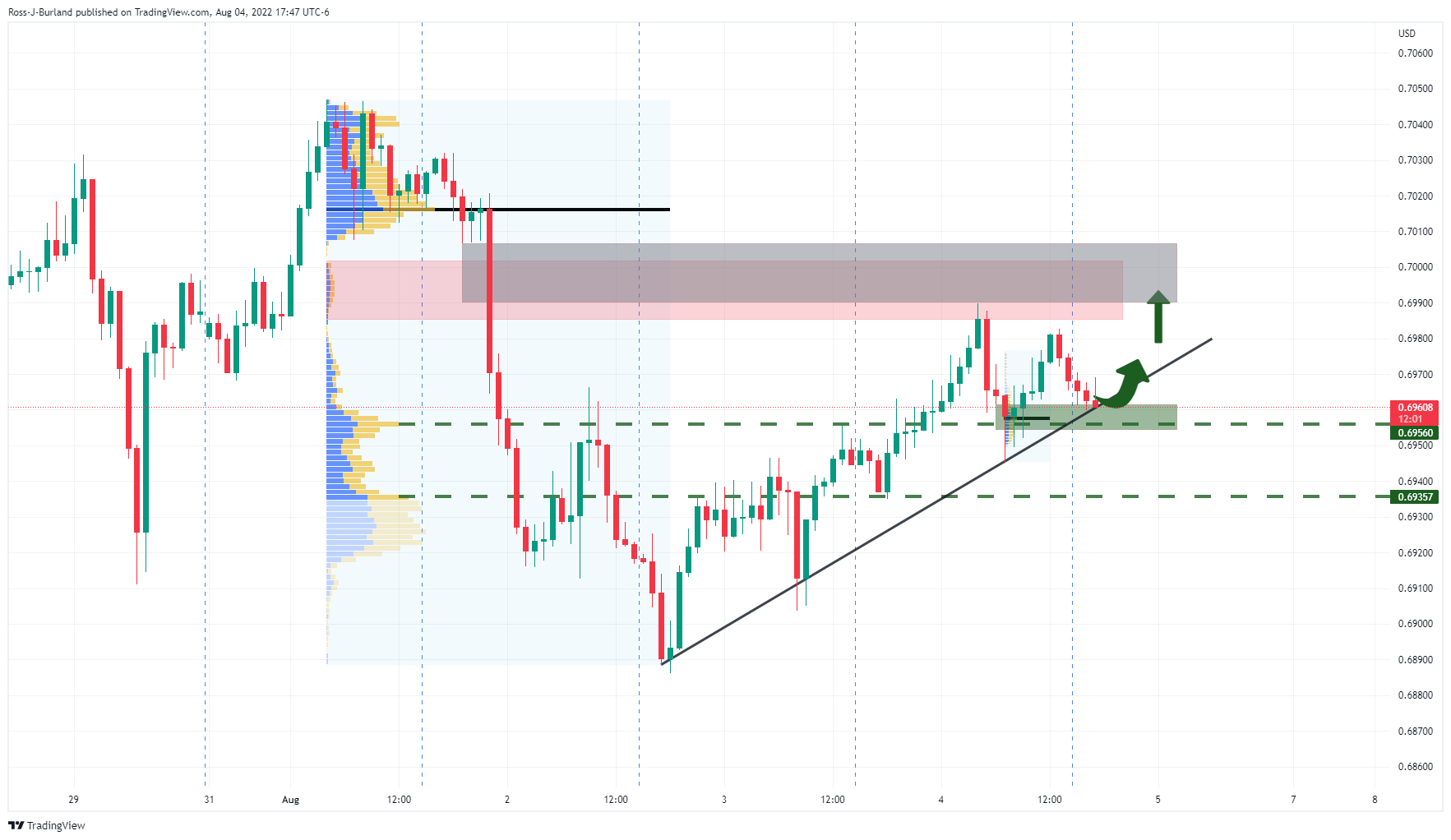
Update...
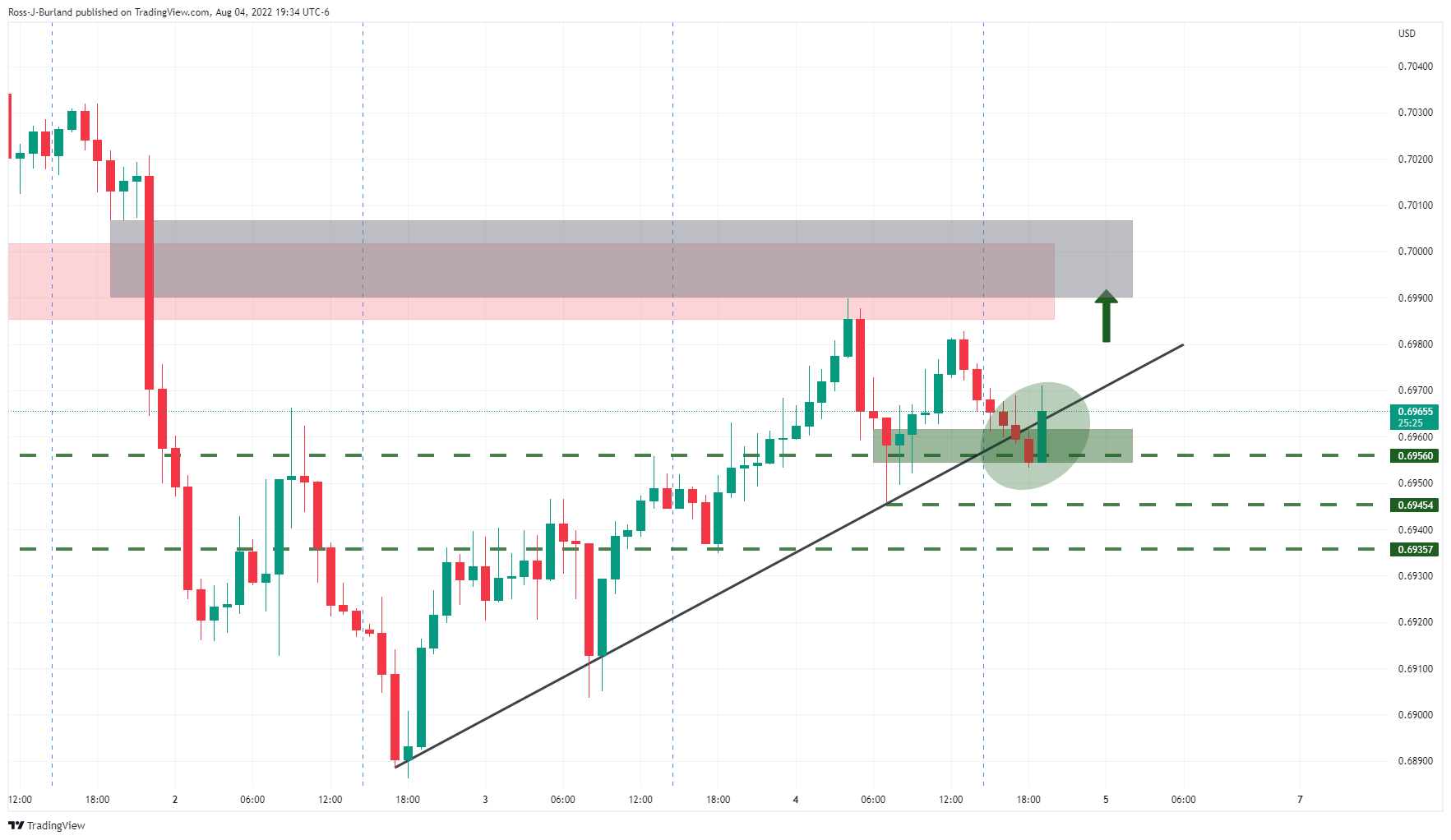
About the RBA Monetary Policy Statement
The RBA Monetary Policy Statement is released by the Reserve bank of Australia reviews economic and financial conditions, determines the appropriate stance of monetary policy and assesses the risks to its long-run goals of price stability and sustainable economic growth. It is considered as a clear guide to the future RBA interest rate policy. Any changes in this report affect the AUD volatility. If the RBA statement shows a hawkish outlook, that is seen as positive (or bullish) for the AUD, while a dovish outlook is seen as negatvie (or bearish).
USD/CHF picks up bids to consolidate the biggest daily loss in a week around 0.9560 during Friday’s mid-Asian session. In doing so, the Swiss currency (CHF) pair justifies upbeat signals from the options market as traders await the key US employment report for July.
That said, one-month USD/CHF risk reversal (RR), a difference between call and put options, printed the three-day uptrend while flashing a 0.080 figure by the end of Thursday’s North American session.
With this, the options market gauge braces for the biggest weekly gains in five as the RR prints the 0.180 mark for the week.
The recovery moves, however, remain elusive as the US dollar Index (DXY) struggles to snap a two-week downtrend amid softer yields and recession fears.
Also read: USD/CHF turns sideways around 0.9550 ahead of US NFP
In recent trade today, the People’s Bank of China (PBOC) set the yuan (CNY) at 6.7405 vs. the previous fix of 6.7636 and the prior close of 6.7485.
About the fix
China maintains strict control of the yuan’s rate on the mainland.
The onshore yuan (CNY) differs from the offshore one (CNH) in trading restrictions, this last one is not as tightly controlled.
Each morning, the People’s Bank of China (PBOC) sets a so-called daily midpoint fix, based on the yuan’s previous day's closing level and quotations taken from the inter-bank dealer.
- GBP/USD reverses the previous day’s bounce off weekly low.
- Pause in yields appeared to have backed the pre-NFP US dollar rebound.
- BOE matched wide market forecasts but recession woes drowned cable before recovery moves.
- US employment numbers, China-linked risk catalysts also appear important for clear directions.
GBP/USD retreats to 1.2140 while reversing the previous day’s rebound from the weekly bottom during Friday’s Asian session. In doing so, the cable pair justifies the US dollar’s corrective pullback ahead of all-important US employment numbers for July.
That said, fears of recession and mixed data, as well as cautious sentiment ahead of the US Nonfarm Payrolls (NFP), seem to weigh on the gold prices during a sluggish Asian session.
On Thursday, the Bank of England (BOE) matched market forecasts by announcing the biggest rate hike since 1995 by increasing the benchmark rate by 50 basis points (bps) to 1.75%. Only one Monetary Policy Committee (MPC) member Silvana Tenreyro voted to hike the rate by 0.25 bps.
Despite the heavy rate lift the GBP/USD slumped nearly 100 pips as the Rate Statement revealed that the UK is projected to enter recession in Q4 2022 and the same is likely to last five quarters. The BOE also mentioned that the Gross Domestic Product (GDP) could fall by 2.1%.
While trying to tame the bears, BOE Governor Andrew Bailey said that parts of the UK economy are still going forward strongly, including in the job market. Even so, the policymaker said, “50 bp rate rise today does not mean we are now moving to a pre-determined path of raising rates by 50 bp per meeting.” BOE’s Bailey also added, “All options are on the table for the September meeting and beyond.”
It’s worth noting that the US Treasury yields continued to portray the risk of recession as the difference between the 10-year and 2-year bond coupons remain the widest since 2000. That said, the US 10-year Treasury yields closed near 2.069% while the 2-year counterpart dropped to 3.049% at the latest.
In addition to the yields, headlines surrounding China and Russia are also likely to have weighed on the GBP/USD price. Recently, the dragon nation’s heavy military drills near the Taiwan border gained major attention and challenges the global trade channel, which in turn should mark further strain on the supply chain and might create an imbalance in the oil supply-demand matrix. However, the same could also escalate the recession fears and may not be that effective. On the other hand, Russia’s sustained invasion of Ukraine has been old news and hence gained little attention from the markets.
Amid these plays, S&P 500 Futures print mild gains despite Wall Street’s mixed closing. Further, the US Dollar Index (DXY) rebounds to 105.87, snapping a two-day downtrend.
Moving on, GBP/USD traders should pay attention to the US NFP details for fresh clues. Also important will be the updates on the UK Prime Minister’s race and Brexit.
Also read: Nonfarm Payrolls Preview: High expectations set deal the dollar a blow, create buying opportunity
Technical analysis
A daily closing below the three-week-old support-turned-resistance, at 1.2180 by the press time, directs GBP/USD towards the 21-DMA support level of 1.2035.
- US dollar is a key focus in the lead-up to the NFP event.
- The bulls are trying to move away from a key area of support.
The US dollar was lower vs. most major currencies on Thursday. On Friday in Tokyo, the index, DXY, is under pressure at around 105.85. The positive impact of hawkish Federal Reserve comments faded this week while investors waited for more signs on the data front. This brings jobs into focus. We have US Nonfarm Payrolls coming up.
Nonfarm payrolls are expected to have risen by 300,000 in July, with an uptick in participation, keeping the unemployment rate at 3.6%, Morgan Stanley said in a note Thursday. It investment bank expects that average hourly earnings to have risen 0.4%, lowering the year-over-year rate to 5%.
Meanwhile, Initial Jobless Claims increased in the final week of July by 6k to 260k data showed on Thursday. ''Continuing claims (to 23 July) lifted, providing clear evidence that the heat is starting to come out of the US labour market,'' analysts at ANZ Bank explained.
''The challenger job cuts data painted a similar picture with hiring announcements at their lowest since November. The number of jobs in July cuts eased from the previous month when numbers really shot up, but are still elevated. However, the number of job cuts is still way lower than in the 2001 and 2008 recessions.''
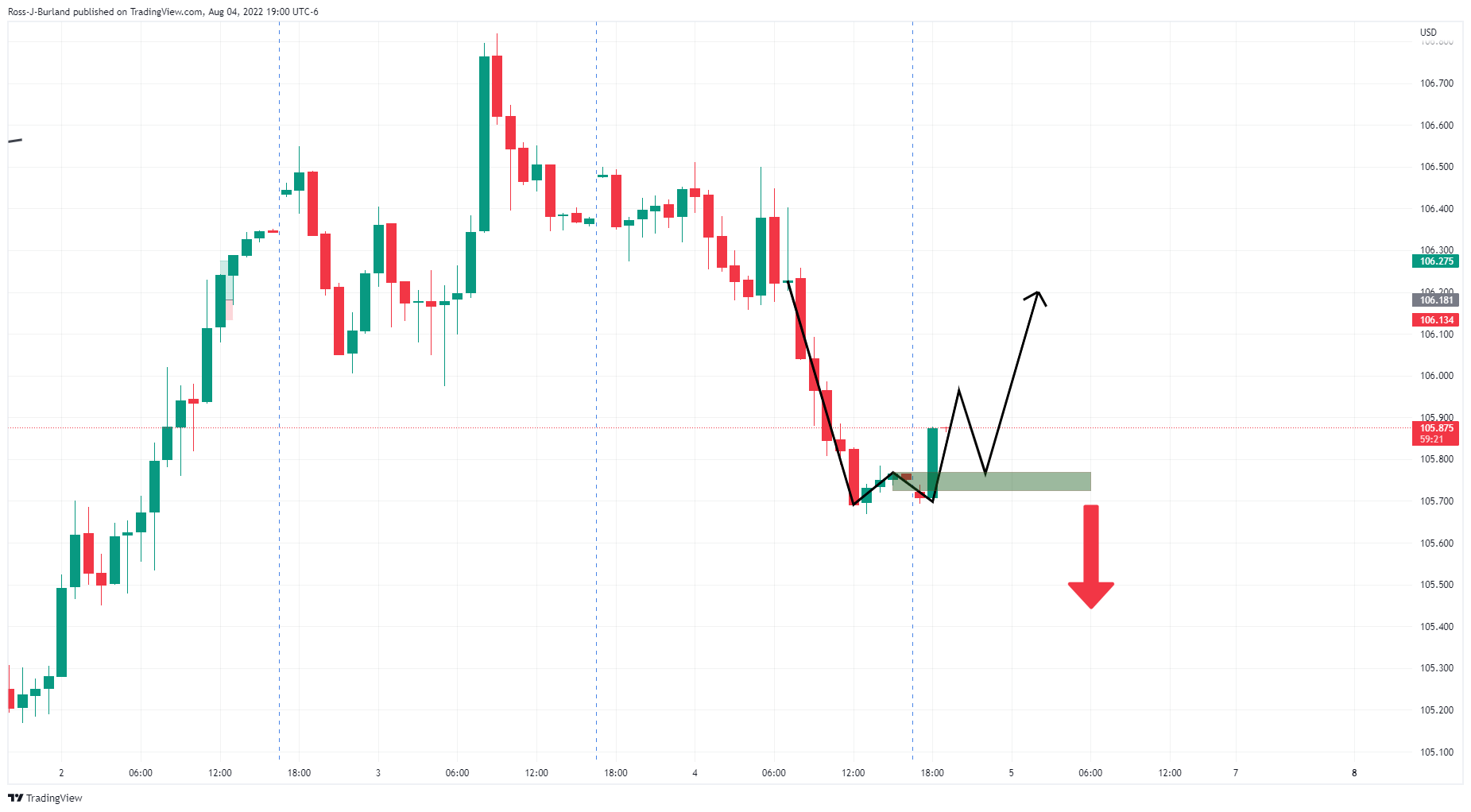
The price is carving out a W-formation on the hourly chart which could hamstring the bulls. A break of the neckline to the downside opens risk of a downside continuation.
- EUR/GBP is advancing towards 0.8450 swiftly as a consensus for UK inflation has spurted to 13%.
- Lower earnings and now higher inflation expectations will create more troubles for the BOE.
- The German Factory Orders have squeezed by 0.4% vs. 0.2% recorded earlier.
The EUR/GBP pair has turned sideways around 0.8430 in the Tokyo session after a juggernaut upside move from 0.8360 on Thursday. The cross displayed a sheer upside after the Bank of England (BOE) raised its interest rates by 50 basis points (bps). It was a consecutive 50 bps rate hike by the BOE, which pushed the interest rates to 1.75%.
The investing community is aware of the fact that earnings by UK households have remained vulnerable in the past few months. Apart from that, the inflation rate is sky-rocketing in the economy. Earlier, the inflation rate landed at 9.4%. Now, the statement from BOE Governor Andrew Bailey that the price pressures could reach 13% has created havoc in the sentiment of the market participants.
The runaway inflation is now turning into a galloping one and the BOE has very less room for tightening its policy. Thanks to the subdued economic data and the ongoing political instability after the resignation of UK PM Boris Johnson, which have created a bummer situation for the BOE. In case of the occurrence of an inflation rate near 13%, a situation of recession in the UK economy is highly likely.
On the Eurozone front, German Factory Order data have squeezed by 0.4% vs. the expectation of a squeeze by 0.8% and the prior squeeze of 0.2% on a monthly basis. A lower Factory Orders figures are indicating dismal overall demand in Germany. It is worth noting that Germany is a core member of The European Union (EU) and German economic data carries a significant impact on the shared currency bulls.
- EUR/USD takes offers to refresh intraday low, pares the biggest daily gains in more than a week.
- RSI pullback, presence of multiple resistance challenge buyers.
- Three-week-old ascending trend line restricts immediate downside.
EUR/USD renews intraday low around 1.0235 as it takes a U-turn from the key resistance line during Friday’s Asian session.
In doing so, the major currency pair also tracks a retreat of the RSI (14), as well as portrays the markets’ cautious mood ahead of the US Nonfarm Payrolls (NFP) data for July.
With this, the EUR/USD prices are likely to witness further downside towards the 1.0200 threshold before the 23.6% Fibonacci retracement level of the June-July downturn challenges the bears around 1.0145.
However, an upward sloping support line from July 18, close to 1.0125 at the latest, could challenge the pair bears afterward, if not then the parity level and the recent low near 0.9950 will be in focus.
Alternatively, an upside break of the aforementioned resistance line, near 1.0250 by the press time, will jostle with the 1.0265-70 resistance confluence including the 38.2% Fibonacci retracement level and the 200-SMA.
It’s worth noting that, the EUR/USD run-up beyond 1.0270 needs validation from the monthly horizontal resistance area, around 1.0280 to give control to the bulls.
EUR/USD: Four-hour chart
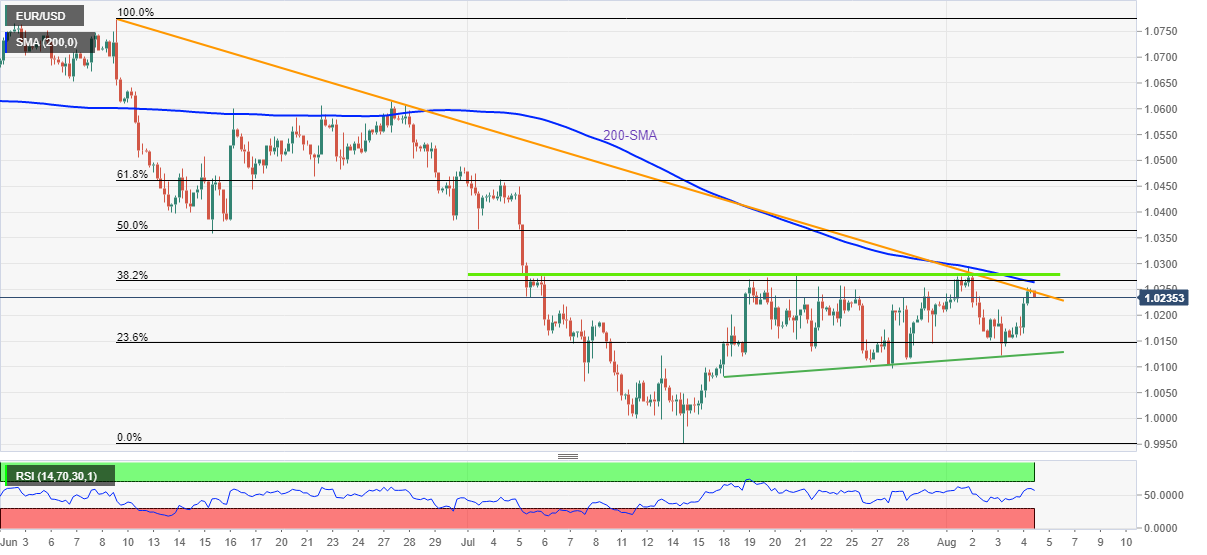
Trend: Limited downside expected
JP Morgan tried to solve the riddle over the firmer equities despite recession risk during late Thursday. The US bank initially termed the firmer shares as short covering as folks re-assess the macro environment. Many believe that the Fed re-centres from inflation to growth and if growth continues to disappoint that brings the end of the tightening cycle earlier
Following that, better than expected earnings from MegaCap Tech and retail bid were cited as the catalysts for the equity run-up. JP Morgan also said, “A ton of money is on the sidelines, so light volume and low liquidity. This is exacerbating the move higher but we have not seen many institutional investors chase this rally. Instead, many believe this is another bear rally.”
While providing the outlook, the US bank mentioned, “At some point, that money on the sidelines is pulled into the market but many investors think we need to retest, and make new lows.”
“In terms of Tech outperformance, if we have seen the highs in yields (3.47% on June 14) and we're going to be in a low growth environment then MegaCap Tech is arguably the best long irrespective of the shape of the yield curve,” the JP Morgan mentioned additionally.
Also read: Forex Today: Dollar at risk of falling further
| Index | Change, points | Closed | Change, % |
|---|---|---|---|
| NIKKEI 225 | 190.3 | 27932.2 | 0.69 |
| Hang Seng | 406.95 | 20174.04 | 2.06 |
| KOSPI | 11.66 | 2473.11 | 0.47 |
| ASX 200 | -1 | 6974.9 | -0.01 |
| FTSE 100 | 2.36 | 7448.06 | 0.03 |
| DAX | 75.12 | 13662.68 | 0.55 |
| CAC 40 | 41.33 | 6513.39 | 0.64 |
| Dow Jones | -85.68 | 32726.82 | -0.26 |
| S&P 500 | -3.23 | 4151.94 | -0.08 |
| NASDAQ Composite | 52.42 | 12720.58 | 0.41 |
- USD/JPY is expected to shift lower to bear 132.00 on a lower consensus for US NFP.
- Fed policymakers have come forward with a new target of above 4% for interest rates.
- Japan’s Overall Household Spending has increased significantly to 3.5%.
The USD/JPY pair is declining sharply after facing barricades around 133.00 in the Asian session. The asset has printed a low of 132.77 and is likely to drag further to near 132.00 as investors are expecting a vulnerable performance from the US Nonfarm Payrolls (NFP) data.
After the consensus of 250k job addition in the month of July, economists at JP Morgan predict the US Nonfarm Payrolls (NFP) to come in weaker at 200K in July’s labor market report. In the month of June, the US economy added 372k jobs in the labor market. A continuous slash in job creation data is advocating severe pressure on the labor market. However, the jobless rate will remain stable at 3.6%.
Rising interest rates and its multiplier effects have triggered downside risks in the labor market activities. The corporate players are unable to invest unhesitatingly due to costly dollars. Therefore, lower investment opportunities are unable to accelerate the employment generation process.
The US dollar index (DXY) has surrendered the support of 106.00 despite the higher targets for interest rates by Federal Reserve (Fed) policymakers. Cleveland Fed President Loretta J. Mester is seeing interest rates above 4% as halting the policy tightening program without finding a slowdown in the inflation rate for months is not feasible.
On the Tokyo front, the Overall Household Spending has improved dramatically to 3.5% from the prior release of -0.5% and the expectations of 1.5%. This may support the yen bulls as the economic data is an inflation indicator. A decent improvement in the economic data advocates that the inflation rate may accelerate further. However, the data could be driven majorly by soaring energy bills. Still, to keep the inflation rate above 2%, an increase in Labor Cost Index is imminent.
| Pare | Closed | Change, % |
|---|---|---|
| AUDUSD | 0.69655 | 0.25 |
| EURJPY | 136.295 | 0.11 |
| EURUSD | 1.02478 | 0.78 |
| GBPJPY | 161.691 | -0.56 |
| GBPUSD | 1.21575 | 0.1 |
| NZDUSD | 0.62958 | 0.37 |
| USDCAD | 1.28623 | 0.15 |
| USDCHF | 0.95483 | -0.58 |
| USDJPY | 133.015 | -0.65 |
- Gold price remains on the front foot around one-month high, mildly bid after crossing 50-DMA hurdle.
- Treasury yields drown US dollar amid recession woes but pre-NFP sentiment and three-month-old resistance zone can challenge XAU/USD bulls.
- China-linked fears also appear interesting to track for fresh impulse.
- US July Nonfarm Payrolls Preview: Analyzing gold's reaction to NFP surprises
Gold price (XAU/USD) grinds higher around $1,795 during Friday’s Asian session, after refreshing the monthly top the previous day. The metal marked the biggest daily gains in five months on Thursday amid a softer US dollar and the rush to risk safety amid recession fears.
That said, the US Dollar Index (DXY) reversed from the weekly top to print the biggest daily fall since July 27, pressured around 105.80 at the latest, amid downbeat US Treasury yields.
The US Treasury yields continued to portray the risk of recession as the difference between the 10-year and 2-year bond coupons remain the widest since 2000. That said, the US 10-year Treasury yields closed near 2.069% while the 2-year counterpart dropped to 3.049% at the latest.
Further, the Bank of England’s (BOE) open acceptance of the economic slowdown in late 2022 amplified the fears. On the same line was Cleveland Fed President Loretta Mester who said that recession risks have increased in the US.
Talking about the data, the US Initial Jobless Claims rose to 260K for the week ended on July 30 versus 254K prior and 259K expected. Further, job cuts eased and German Factory Orders improved while the US Goods and Services Trade Balance improved to $-79.6B versus $-80.1B market consensus and $-84.9B revised prior. Despite the mixed data, the market players remained hopeful of the Fed’s aggression but that couldn’t lift the US dollar amid fears of recession.
Amid these plays, Wall Street closed mixed and the S&P 500 Futures remain directionless at the latest.
Looking forward, gold traders may wait for the US Nonfarm Payrolls (NFP) for July, expected 250K versus 372K prior, for clear directions as recession fears jostle with the Fed’s aggression. Even so, the softer US dollar is likely to keep XAU/USD buyers hopeful.
Technical analysis
Gold price marked the first daily closing beyond the 50-DMA, around $1,789 by the press time, since late April on Thursday. The DMA breakout also gained support from the upbeat RSI (14) and the bullish MACD.
With this, XAU/USD bulls are all set to challenge the area comprising multiple lows marked since May, around $1,805-07. However, a downward sloping resistance line from April 29, near $1,830 at the latest, could restrict the metal’s further advances.
Following that, the 50% and 61.8% Fibonacci retracements of April-July downside, close to $1,840 and $1,877 in that order, might lure the gold buyers.
Meanwhile, pullback moves remain elusive until the quote stays beyond the two-week-old support line, at $1,868.
Even if the gold price declines below the $1,868 support line, the 21-DMA level near $1,838 could challenge the bears.
Gold: Daily chart
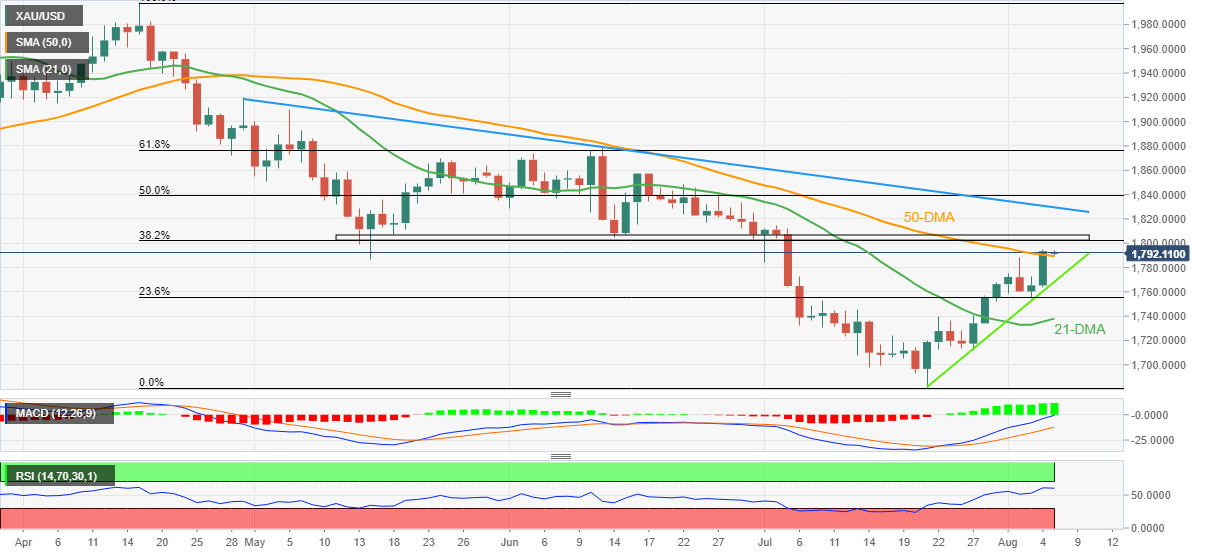
Trend: Further upside expected
- AUD/USD bears are lurking but there could be more from the bulls in the meantime.
- The price is under pressure but should hourly support hold, the 0.7000s will be eyed.
As per the prior analysis, AUD/USD Price Analysis: Bulls seeking higher grounds into key data events, the price has rallied as anticipated but is yet to pierce the 0.7000s.
AUD/USD H1 chart
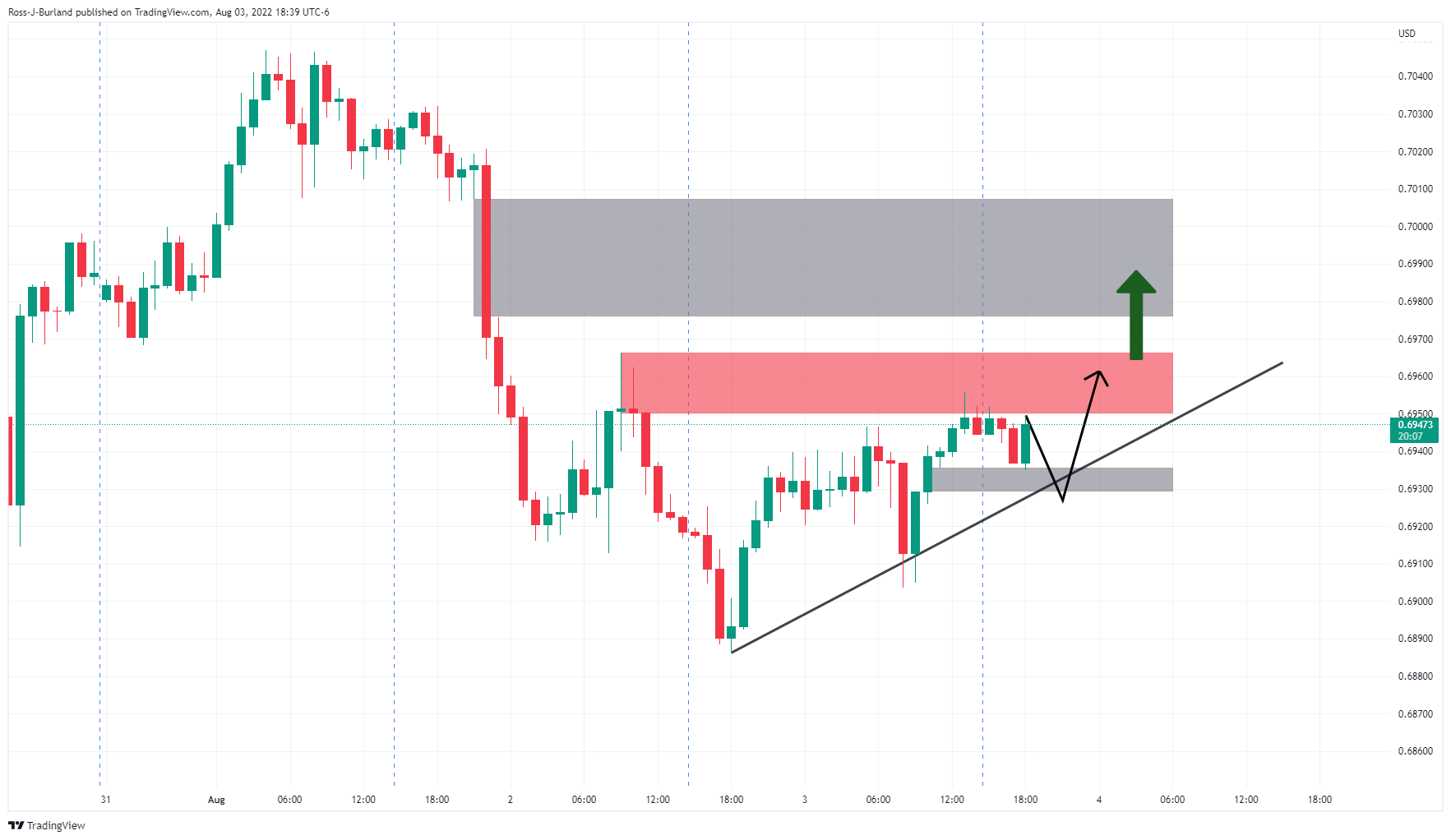
The price was trapped between a supporting trendline and horizontal resistance. There was a price imbalance that will be mitigated in due course, but so far, the bulls have stayed in control above 0.6950 in the main:
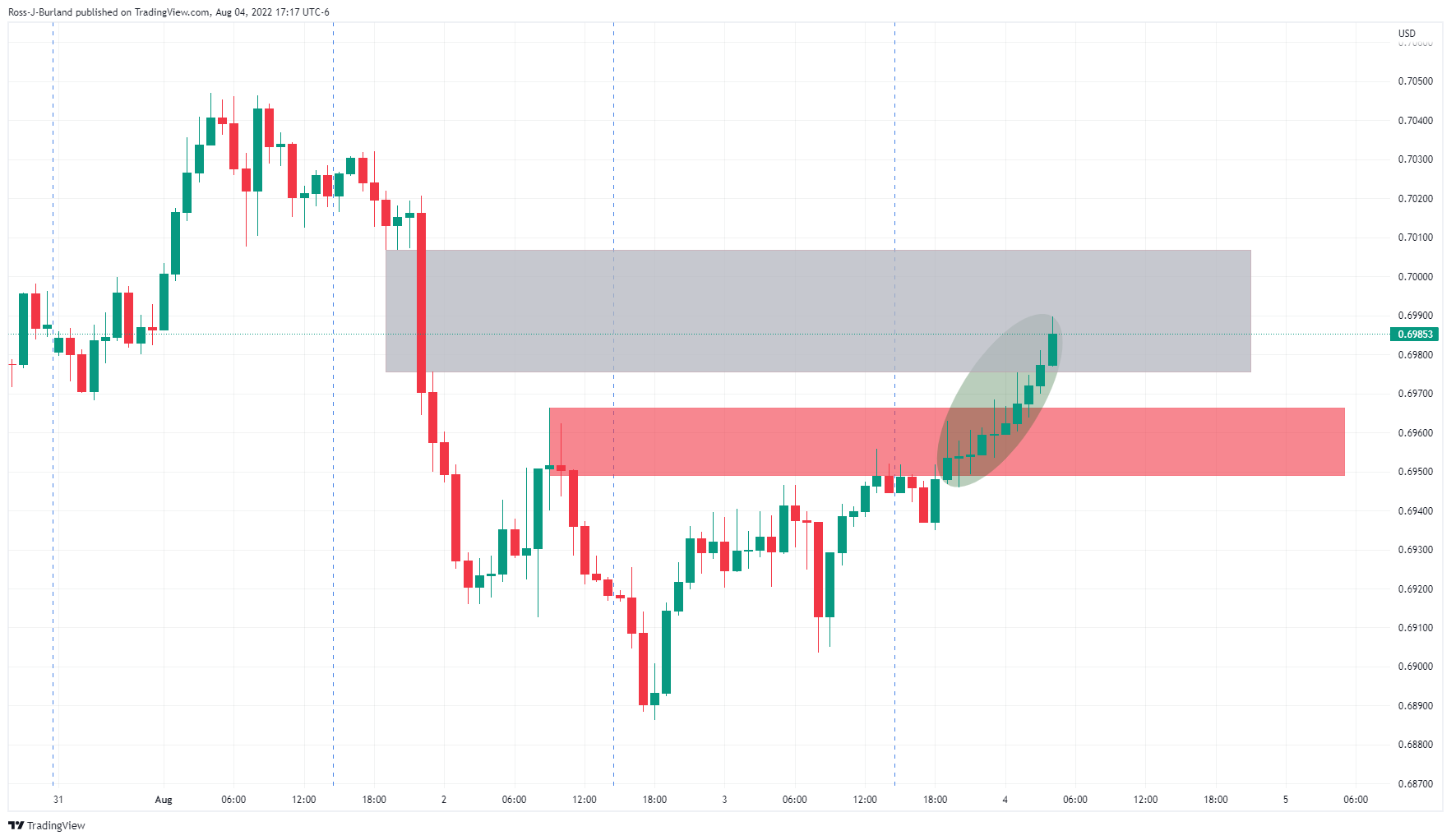
AUD/USD live market

The price has since been knocked back by the bears from a higher volume area and is trapped between there and the support as illustrated above. However, the recent grind lower is relatively weak and should the bulls commit above 0.6950, there will be prospects of another bullish run for the day ahead.
A break of 0.6980 resistance opens risk to 0.7000 in order to mitigate the price imbalance above between 0.6990 and 0.7007. The point of control of the prior bearish trend is located a little higher up at around 0.7020.
AUD/USD daily chart
In moving higher, the price will be on track to complete the reversion to the M-formation's neckline as illustrated in the line chart above.
AUD/USD weekly chart
However, this could be a pump and dump scenario considering the W0formation on the weekly chart:

While the price has already checked the neckline of the formation, there could still be more to come from the bears before the week is out and much will depend on the Nonfarm Payrolls event ahead of next week's US inflation data.
Meanwhile, should the price simply deteriorate, the 15-min chart's structure could be important:
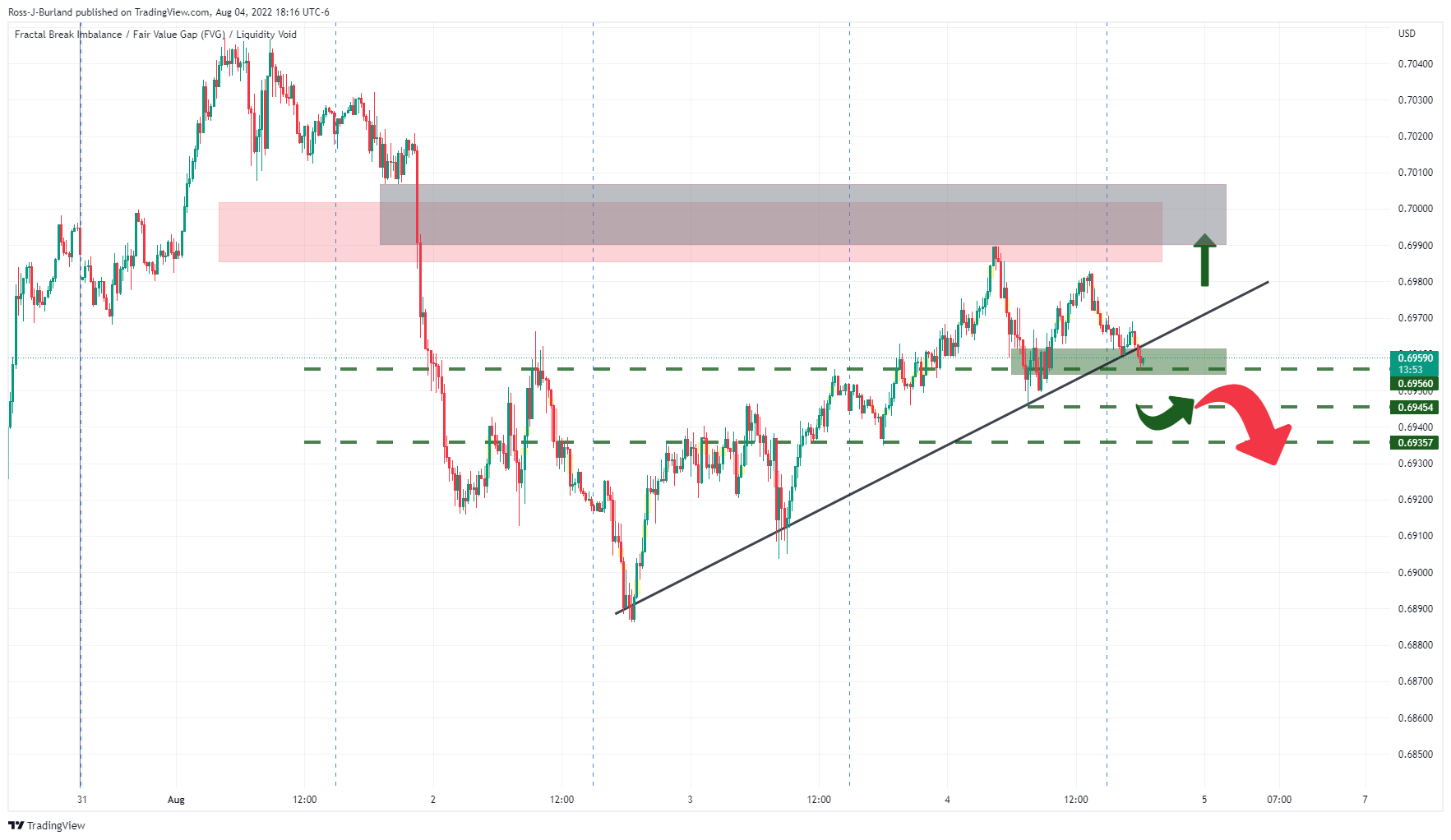
© 2000-2024. Sva prava zaštićena.
Sajt je vlasništvo kompanije Teletrade D.J. LLC 2351 LLC 2022 (Euro House, Richmond Hill Road, Kingstown, VC0100, St. Vincent and the Grenadines).
Svi podaci koji se nalaze na sajtu ne predstavljaju osnovu za donošenje investicionih odluka, već su informativnog karaktera.
The company does not serve or provide services to customers who are residents of the US, Canada, Iran, The Democratic People's Republic of Korea, Yemen and FATF blacklisted countries.
Izvršenje trgovinskih operacija sa finansijskim instrumentima upotrebom marginalne trgovine pruža velike mogućnosti i omogućava investitorima ostvarivanje visokih prihoda. Međutim, takav vid trgovine povezan je sa potencijalno visokim nivoom rizika od gubitka sredstava. Проведение торговых операций на финанcовых рынках c маржинальными финанcовыми инcтрументами открывает широкие возможноcти, и позволяет инвеcторам, готовым пойти на риcк, получать выcокую прибыль, но при этом неcет в cебе потенциально выcокий уровень риcка получения убытков. Iz tog razloga je pre započinjanja trgovine potrebno odlučiti o izboru odgovarajuće investicione strategije, uzimajući u obzir raspoložive resurse.
Upotreba informacija: U slučaju potpunog ili delimičnog preuzimanja i daljeg korišćenja materijala koji se nalazi na sajtu, potrebno je navesti link odgovarajuće stranice na sajtu kompanije TeleTrade-a kao izvora informacija. Upotreba materijala na internetu mora biti praćena hiper linkom do web stranice teletrade.org. Automatski uvoz materijala i informacija sa stranice je zabranjen.
Ako imate bilo kakvih pitanja, obratite nam se pr@teletrade.global.
